-

-
- 2009 Film Review - Star Trek
-
-
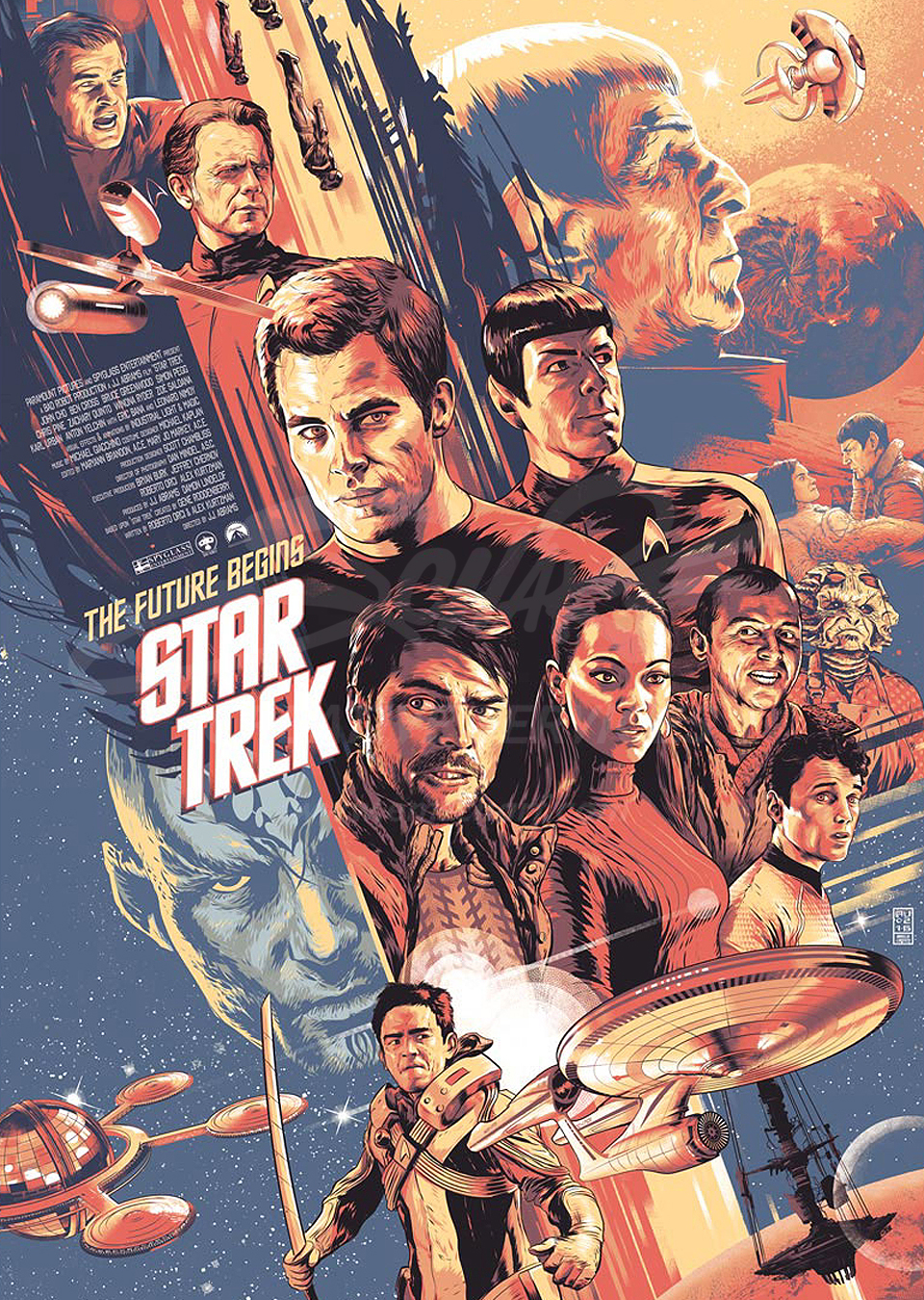
-
-
- June 2,
2009
- By Eric M. Scharf
-
- Disclaimer: This
review contains a historical build-up, with commentary on all
preceding television series and feature films, leading to a review
of the latest movie itself. After all, you need to know from whence you came before you can “boldly
go where no one has gone before . . . again.” Otherwise, those
disinterested in
“Star Trek” lore are encouraged to skip ahead to “The Latest
Attempt.”
The History
Science fiction, beginning with the Industrial Revolution, has been
a part of human culture for at least 200 years. It has been
delivered to society in all forms of media, with some derived from
fact and many others from imagination.
The best of the best, however, either compels you to believe it will
be real or leaves you dreaming of the day when the unimaginable
becomes reality.
While there have been millions of amazing treks into the science
fiction abyss, with great respect to the original three-film Star
Wars saga, it is the enduring voyage of the Federation starship USS
Enterprise that has captured the imagination of so many for so long.
"Space: the final frontier. These are the voyages of the starship
Enterprise. Its five-year mission: to explore strange new worlds; to
seek out new life and new civilizations; to boldly go where no man
has gone before."
“Star Trek” has gone on much longer than its original five-year
mission, exposing fans to one possible highly-civilized utopian
future, where all of humanity is collaborative, respectful, and
supportive of one another; where uniqueness is more celebrated than
shunned, and where healthy debate over issues, rather than heated
arguments resulting in death, is the norm.
“Star Trek” has been the best artificial example of what the
determined among our society
could possibly achieve in the distant future (having always provided a careful balance between interstellar action
and an ongoing study of the human / alien condition).
Gene Roddenberry’s near-immortal creation has become a science
fiction story-telling franchise of immense proportions, thus far
enjoying more than 45 years of history, spanning five television series
and eleven feature films. Such an incredible timeline (as well as
any reader of this review who is no more than a casual “Star Trek”
fan) requires some serious introspection before getting to the main
attraction.
The Television Series

-
-

-
-
- "The Media Magnate" loved the original “Star Trek”
series. After all, it was the original cast and crew. James T. Kirk
was the extremely resourceful and swashbuckling risk-taker. Mr.
Spock was the otherworldly by-the-book perfectionist except for when the human condition
interfered. Dr. Leonard "Bones" McCoy was the worry wart who
simultaneously went along with his colleagues and chewed them out
when, inevitably, their plans were too risky or too stringent for
his taste.
Hikaru Sulu was the savvy helmsman who could pilot
anything in a pinch. Uhura was the attractive linguist whose dynamic
hails bailed Enterprise out of more than one intergalactic jam.
Pavel Chekov was the happy-go-lucky ensign with a tactical and
starship weapons bent. Montgomery "Scotty" Scott was the chief
engineer who could always find a way to squeeze more Dilithium blood out of a
warp speed turnip
than anyone else.
Fans (and those who
became fans once the cult following really began to pick up steam)
were introduced to so many different and unique characters, races,
and worlds, as well as the strange and fantastic scenarios that
intertwined them all. And the personal growth of each character
(through in television, films, and numerous novels) over nearly five
decades has been astounding.
- There are dozens upon dozens of unique science
fiction television shows that have tried and failed to match the
magic, the cast camaraderie, and the following generated by “Star
Trek.” Some Trek-inspired series that have succeeded to a degree
were “Babylon 5,”
“Farscape,” and “Stargate SG-1,” which ran an amazing 10 years
before giving way to the less successful (but still-popular) “Stargate Atlantis.”

-
-
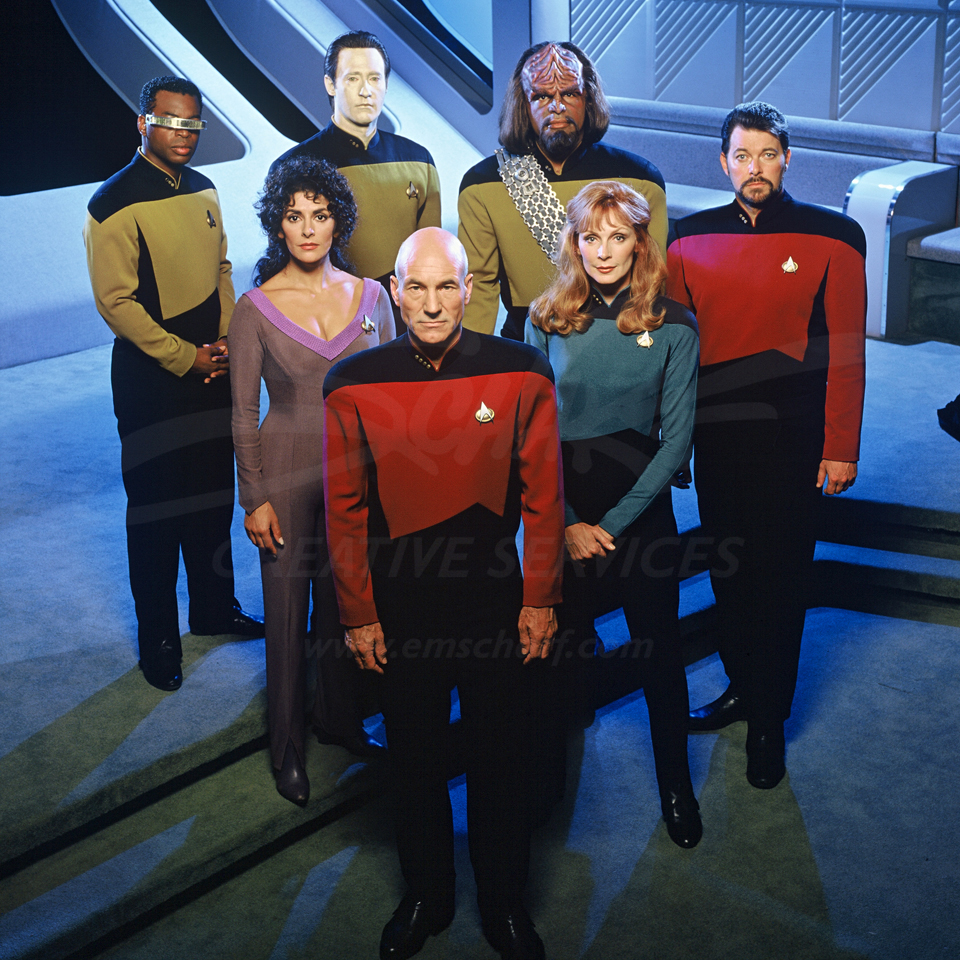
-
- The Media Magnate very much enjoyed and appreciated
what was attempted with “Star Trek: The Next Generation (STTNG)” series.
Fans were introduced to even more unique worlds, intriguing space
facilities, and fascinating races, including the greedy, untrustworthy Ferengi and “Q,” one of many curious and unbelievably
meddlesome beings sharing the same name and incredible god-like powers.
-
- A Klingon,
Lieutenant Warf, played impenetrably by Michael Dorn, was another refreshing addition as chief security
officer. His social and tactical familiarity with the Klingon Empire
made him invaluable, as well as his ability to channel his Klingon
heritage into behaving like a prim and proper Starfleet officer, rather
than a 24 / 7
warrior.
-
- An android, Commander Data, played error-free by Brent Spiner, was added as second officer
(and
chief operations officer who desired to become human). This
desire, at one point, resulted in his creation of an android
daughter, with superior capabilities and an even more refined
ability to be truly emotive.
Nonetheless, he was the
subliminal replacement for Spock, and in the same vein, someone who
struggled just as much to find his place within humanity, even with
his emotion microchip activated. His raw speed of analysis and
action, in physical and technical tasks, was both overwhelming and
cherished, especially with his constant pursuit of improvement. Both Warf and Data proved to be so
much more, in character and value, over time.
-
- The Media Magnate even has an incredibly embarrassing story
about meeting Patrick “Jean Luc Picard” Stewart (a personal favorite
among a handful of best-possible actors) during his son’s graduation from California Institute of the
Arts, The Media Magnate's alma mater. Stewart is a brilliant silver screen and
stage actor to this day, and he accomplished more in the role of Picard than what other equally-established colleagues would have
achieved. His approach left you believing he was, in fact, a
combination of three characters from the original series. He
had Kirk's experience, resourcefulness, and combat skills. He
had Spock's appreciation for knowledge, accuracy, and "studying an
unknown," whenever reasonable, before acting in favor of it or
against it. He had Sulu's piloting skills and a commanding
voice made for broadcasting! "Make it so!" - "Number One -
Engage!" Picard's crews, whether aboard Stargazer or
Enterprise, knew he was someone who earned his captain's chair,
rather than simply being the next Starfleet officer in line to fill
a vacancy.
-
- Commander William Riker, played
valiantly by Jonathan Frakes, was the perfect balance for Picard.
Riker was always ready for battle, always ready to remind Picard of
the risk of joining an "away team" on a dangerous mission, and even
as a legitimate captain in waiting, he was always ready to slow down and
listen to the wisdom of his commanding officer. Counselor Deanna Troi had much to offer as an empath, capable of reading the thoughts
and even taking over the minds of some of the most formidable
enemies.
-
- Lieutenant Commander Geordi La Forge, played
crisp-and-clean by LeVar Burton, was chief engineer with the
determination, grit, and knowledge of Scotty and the laser focus of
Spock. You always knew that, no matter how painful the process or
solution was to achieve, La Forge was up to the task of making the
impossible reasonable.
-
- Dr. Beverly Crusher was capable as
chief medical officer but always seemed hesitant at some of the most
critical moments, when focus beyond bedside manner was necessary. Even though she and Picard were intimate, she never used their
relationship to gain favor under any circumstances, unlike some of
Picard's other love interests. Her son, Ensign Wesley Crusher,
however, was simply annoying through no real fault of his own, as he
was part of a starship crew where everyone was significantly older.
-
- While his Starfleet procedural
skills were excellent, and he displayed the technical knowledge of a
chief engineer, he seemed to bounce back and forth between being
spoiled and socially awkward versus possibly turning the maturity corner. If
you are the equivalent of a high school student brilliant enough to
test out of everything, like young Wesley, and transfer directly
aboard a starship for further (Starfleet)
training, your stunted personal growth is understandable but will
not be missed.
-
- There were a number of other
characters, such as the original Chief of Engineering, Miles O'Brien
(played by Colm Meaney), the original Chief of Security, Lieutenant
Tasha Yar (played by Denise Crosby), the manager of the popular "10
Forward" lounge, Guinan (played by Whoopi Goldberg), and edgy Ensign
Ro Laren (played by Michelle Forbes) to name a few, who also left
their collective mark on the series.
-
- This series also ushered in the era
of fully-functional starships, ultra-sterile industrial design,
holodecks, and full-sized phaser pistols that strayed too far. Fully-functional, in this case, refers to how a sizeable piece of a
Federation starship could be destroyed, yet, power could quickly be
re-routed to establish force fields in the exposed regions of the
ship, thus, preventing the escape of atmosphere and the failure of
life support systems. These same force fields could be used to
easily isolate a very specific section of a starship as well,
confining an intruder within what would essentially be a mobile jail
cell.
-
- It was really impressive to see such large ships be able to
endure partial system failures or major damage and still be able to
function in a limited or better-than-limited capacity, potentially
saving a few thousand lives at least, on a ship like the re-designed
"Next Generation" Enterprise. Imagine the modern day space shuttle
losing one of its three on-board rocket engines while attempting to
rendezvous with the International Space Station. It would be great
to be able to re-route the fuel and other related systems from the
failed engine to the other two functional engines. "Recyclable" is
the big catch phrase in this day and age, but the next evolution of
that should, in fact, be "fully-functional."
-
- Ultra-sterile
industrial design, in this case, refers to the incredible fit and
finish, seamlessness, and glossy-surfaced consoles and display
arrays found throughout Federation starships in "Next Generation." Ultra-sterile, ultra-crisp, and ultra-nice, too, unless you are
a filthy slob or a non-Starfleet Klingon.
-
- The holodeck provided a great
controlled environment within which Enterprise's crew could either
entertain themselves or investigate other beings, objects,
environments, and theories in relation to solving real world
problems. A fine example that comes to mind involves when Geordi La
Forge replicated an engineering lab, as well the original designer
of Enterprise's propulsion system, in order to devise a way to allow
the ship's computer to self-navigate an energy-siphoning mine field.
-
- While it certainly served its purpose,
it was always curious as to why the holodeck was so small, versus allowing it to occupy much of the deck
in which it was nestled, other than providing more reasonable camera
angles. After all, if you use the holodeck to conjure up a pasture
with some horses for you and a friend to ride (which has been the
case), then, you are dealing with some subtle, local, real-time
anti-gravity adjustments. If fan desire was not to want it to be so believable,
they would simply shrug their shoulders and accept the holodeck's best as
a budgetary shortcoming.
-
- Regarding the phaser pistols, they
were simply television remote controls, or shapely submarine
sandwiches, dressed up as big, bulky phasers with "Racer X" front
ends. Even if the larger
size carried a longer and more powerful charge, they were not
imaginative. And while the laser rifles were elegant looking, they
were still unnecessarily bulky.
-
- So much of what STTNG
created from scratch, altered, or enhanced from the original series,
provided an important foundation for so much of what occurred within
the following series, as well as some of the films. While it
was only meant to compliment the original series, STTNG
carved a legitimate space for itself as a memorable voyage with a
bit more exploration of strange worlds and new civilizations than
its predecessor.

-
-
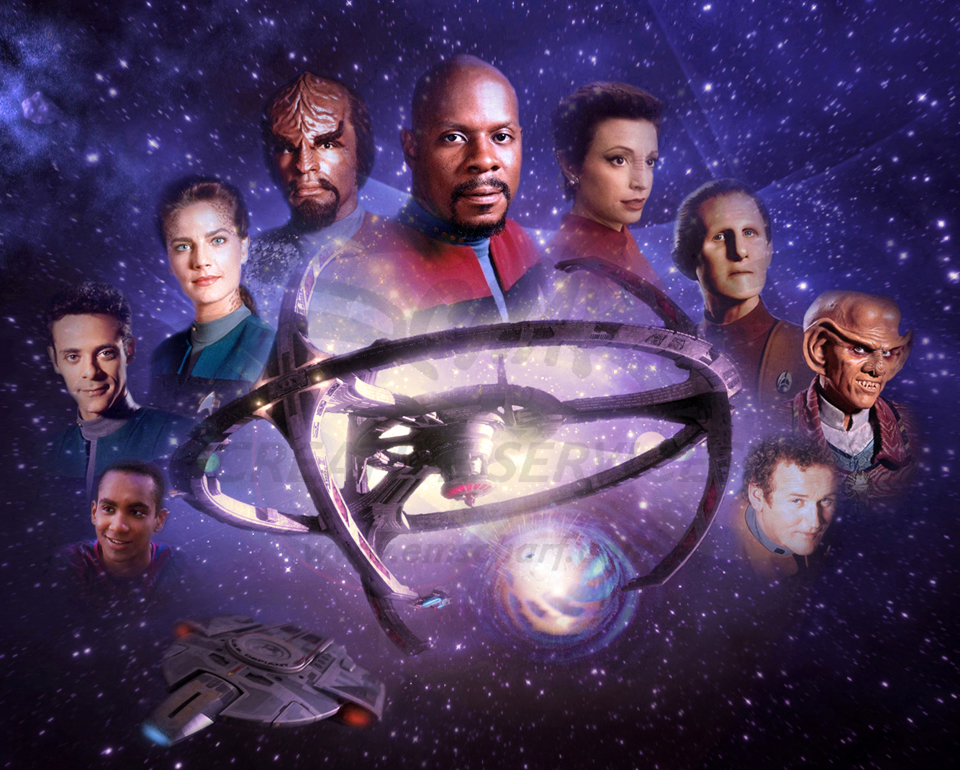
-
- “Star Trek: Deep Space Nine (DS9)” was not
going to last very long as Star Trek’s version of “Mos Eisley in
Space” or “The Restaurant at the End of the Universe” without some
key differences. The high-traffic, space trade and travel hub of
Cardassian design, "where everybody knows your name," really forced the
show writers to create stronger main
characters and more multi-faceted villains.
-
- When the characters and their collaborations were not "Deep
enough," or ran out of previously undiscovered cargo holds to
explore, and when inevitably compared to the laughably lower budget but
arguably better-storied “Babylon 5,” it led to an earlier end to DS9
than anticipated (depending on how immediate when newly-broadcast or
how late in syndication its own fanbase had that "A-HA!" moment and
made that craved connection).
-
- You can play
"hide and go seek" in the same intergalactic watering hole only so many times before
losing interest in the game (or Constable Odo's relentlessly
thorough investigations, sometimes of the same to-be-confiscated
contraband being "marketed" by some of the same Ferengi culprits). Traveling to various
planets for those main characters on a (more) semi-regular basis, using the
"plucky" Defiant, would have helped keep the series fresher, but it would not
have been the savior (for a series that, just more than halfway
through its lifecycle, increasingly had a per-episode budget of
DOUBLE that of STTNG).
-
- “Space 1999,” decades before, however, still
managed to include nearly equal time on both their own hostage
holding cell (Moon Base Alpha) and on
the Eagle spacecraft. And while Avery Brooks always delivered a
commanding performance as Captain Sisko (with a deliberate speaking
style equaled only by Admiral Kirk), he will always (overwhelmingly) be “Hawk” to
The Media Magnate, alongside Robert Urich as part of the crime fighting duo from
the well-received television series “Spencer for Hire.”

-
-
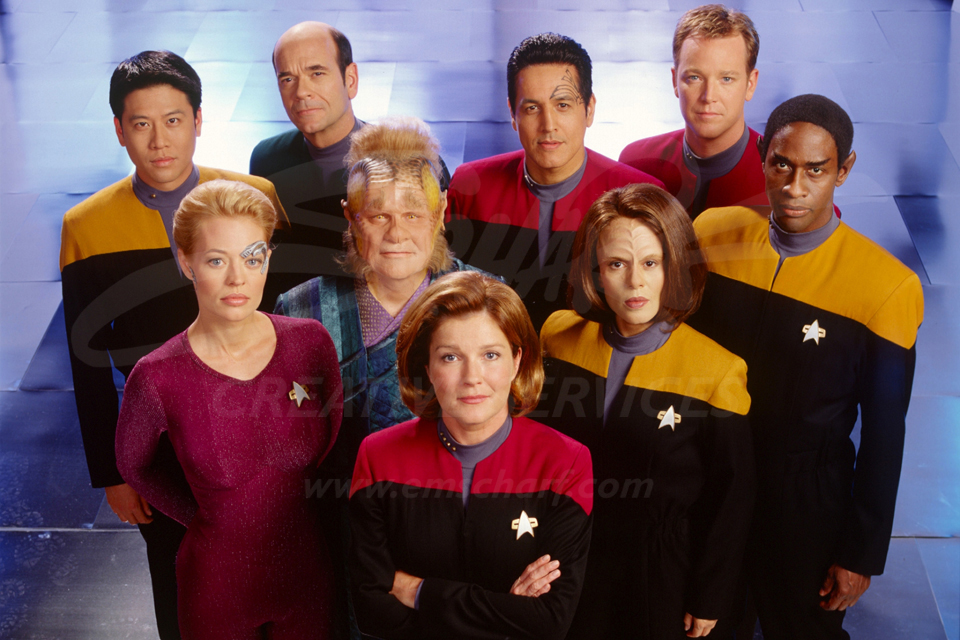
-
- “Star Trek: Voyager (STV)” brought the
decades-old television series back to full-time space exploration,
once more introducing us to strange new worlds and new
civilizations. The premise for the show was built upon starship USS
Voyager entering an unfriendly space nebula called the Badlands, in
pursuit of ex-Starfleet rebels called the Maquis.
-
- Voyager, along
with its target, is transported by a powerful space probe to another
quadrant, approximately 75,000 light years from whence they came.
After seeing the Maquis ship destroyed in a battle with the creator of
the space probe, the Starfleet crew and the Maquis band together
aboard Voyager, on a new mission to return to Federation space.
-
- There
was great intrigue with the first African-American(-looking) Vulcan in Tuvok, as well
as Chakotay, the first Native American(-looking) Starfleet officer (who
collectively brought a number of back stories to the series). Kate Mulgrew
will always command respect as an actress, but the sheer, repeated sound of Captain Janeway saying
“This is Captain Janeway,” or “Chakotay, do you read me?” continues
to give (some) fans nightmares. Though the series only lasted six years,
The Media Magnate is confident Paramount felt better knowing they had another 74,994 light
years worth of episodes in its back pocket.
-

-
-
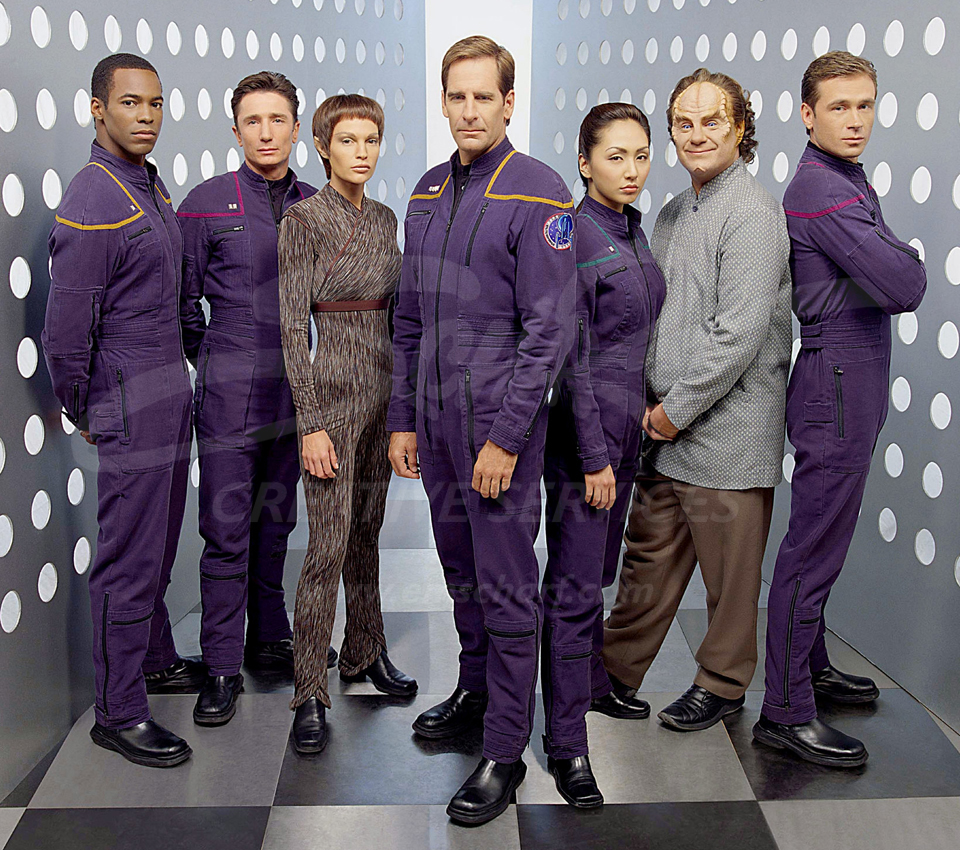
-
- “Star Trek: Enterprise” was an
engaging series with a core set of quality television actors (who
were made for television and smart enough to admit it). Hollywood
veteran Scott Bakula played Captain Jonathan Archer, a nice blend of
Kirk and Picard, taking a cerebral approach to each new encounter,
willing to perform a little research, and then being ready for
action if warranted. Jolene Blalock played (the uncommonly attractive?)
Vulcan Sub-Commander T’Pol (pronounced tip-Paul).
-
- Dominic Keating
played the occasionally over-anxious chief security officer,
Lieutenant Malcolm Reed. John Billingsley played the procedurally
stiff but medicinally flexible alien chief medical officer, Dr.
Phlox. Connor Trinneer, who played the chief engineer, Commander
Charles “Trip” Tucker, really established that character as an “Old
West” equivalent of Montgomery Scott. He always seemed to be at or
near the epicenter of action with a wide range of challenges, and he
never disappointed.
-
- Star Trek: Enterprise, unfortunately, suffered
from some bad timing and a bit of a story disconnect from the
original “Star Trek” series, which the writers only began to truly
address in the final season.
The Films

-
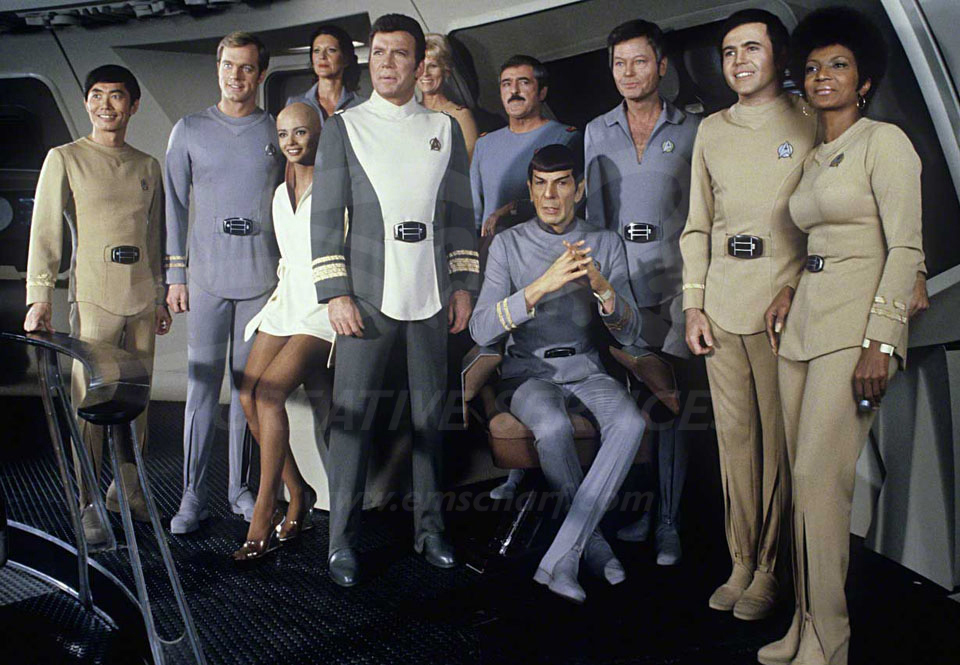
-
- The Media Magnate enjoyed the psychological thriller
that was “Star Trek: The Motion Picture (STTMP)” and was more forgiving
(than most) for some of what it lacked, because it was the silver screen coming
out party for the Enterprise and its crew. Kirk has his midlife
crisis, Spock has recently failed (to finish the ceremony of) Kohlinahr (the formal purging of
all emotion), and McCoy is pissed off that his retirement has been
cancelled.
-
- They have been called back into duty to intercept an
unidentified cosmic cloud heading towards Earth, after the cloud has
easily destroyed three Klingon cruisers that attempted to halt its
progress. Enterprise goes to warp speed to intercept the cosmic
cloud before it can get any closer to Earth. The cosmic cloud scans
Enterprise, but Kirk orders neither return scans nor activation of
shields or weapons, as it might be seen as a sign of aggression.
-
- The
cloud is actually able to communicate with Spock while he is in a
brief trance state. Spock explains to Kirk that the cloud is
attempting to communicate with Enterprise as if it were a living
entity, but the communication is so fast it lasts less than a
second.
-
- Before Spock can make the proper
speed adjustments to the communications system, the cloud sends an
energy beam through Enterprise, causing its systems to begin to
overload. Chekov is hurt in the process, and, then, the beam
subsides. Spock makes the changes and sends out a message to the
cloud before another energy beam can further harm Enterprise.
-
- They
decide to venture forth into the cloud, ultimately ending up in a
tractor beam leading them to the center of the cloud and source
control. Another probing beam hits Enterprise, this time scanning
Lieutenant Ilia, an empath, and she suddenly disappears. She is
returned to the ship soon after as an equally dangerous humanoid
probe of the cloud which, through Ilia, calls itself “VYGER”
(pronounced VEE-JER), otherwise known as the centuries-old NASA
space probe Voyager 6.
-
- And the cloud turns out to be a
truly MASSIVE,
multi-faceted metal construct. There were certainly moments while
Enterprise was within that construct when it felt like watching “2001: A Space Odyssey.” Considering who was in charge of
the special effects, it made sense.
-
- Nonetheless, Enterprise reaches the
center of the construct and VYGER itself. The two newest characters
of the film, in Commander Decker and his empathic alien
ex-girlfriend, Ilia (now VYGER’S probe), accompany the senior
officers to investigate VYGER, up close. After learning that VYGER
wants to lure “the Creator” in close in order to personally complete
its programming, Decker volunteers to manually input the final code.
-
- He also sacrifices himself for a union with the Ilia probe, thus,
providing it with the answers it seeks from “the Creator.” They
embrace and a blinding light takes hold, expanding outward until the
entire structure suddenly disappears, leaving Enterprise and crew
unharmed in orbit around Earth. Decker and Ilia would also prove to
be the basis, in my opinion, for Commander William T. Riker and Counselor
Deanna Troi of the “Star Trek: The Next Generation” series.
-
- This
film also included some long sought after “exploration” of the
physical space on the Enterprise. It is, after all, a huge ship
(notwithstanding VYGER),
capable of holding a couple thousand crew members and, eventually,
fans like me were going to want to see what else lurked beneath that
thick metal hide.
-

-
-

-
- “Star Trek II: The Wrath of Khan (ST2)”
begins with an increasingly bored Admiral Kirk overseeing starship
operations and providing instruction to cadets from behind a
Starfleet Academy desk. Enterprise has become a Starfleet Academy
training ship. Kirk and a handful of friendly faces accompany a
cadet crew on a simple two-week mission involving no more than
standard training maneuvers. Meanwhile, Commander Chekov and Captain
Terrell of USS Reliant have been studying the Ceti Alpha system and
have beamed down to what they mistakenly believe is planet Ceti
Alpha 6.
-
- They discover cargo containers, from the ship Botany Bay,
and Chekov cannot recall his shocking memories soon enough, as they
are captured by one of Kirk’s most capable enemies, Khan Noonian
Singh, played brilliantly (once more) by Ricardo Montalban. Upon finding out
that Kirk is not only alive but successful, a vengeful Khan and his
loyal followers beam aboard Reliant with their two captives, where
they murder the rest of Reliant’s crew and set off after Enterprise.
Reliant, as a bonus to Kahn, has been assigned to assist Space
Station Regula 1 with the testing of a top secret hyper-terraforming
device called Project Genesis.
-
-
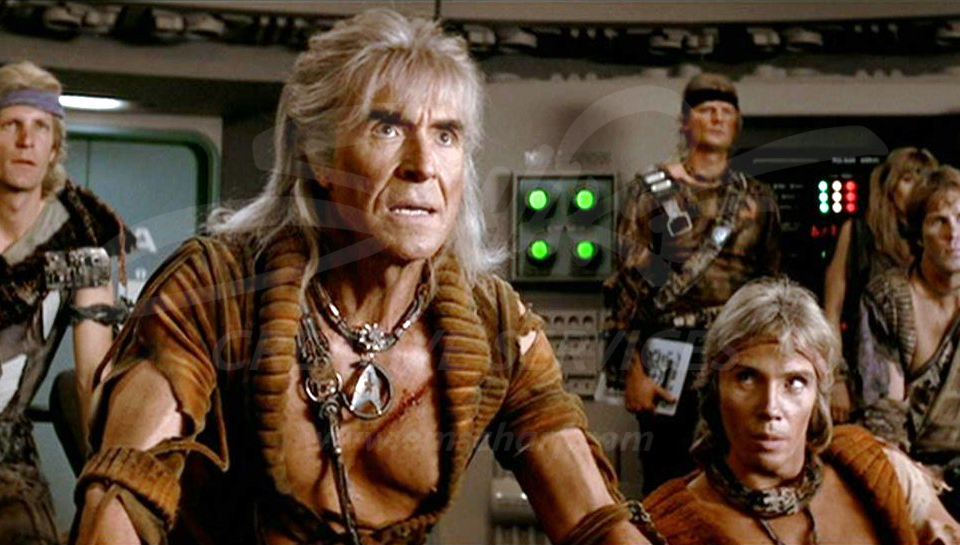
-
- Khan seeks out Enterprise, claiming
communication interference from a warp core overload as the two
ships move closer to firing range. Kirk learns the truth too late,
and Khan, after attacking and severely damaging Enterprise, finally
reveals himself to Kirk, asking him to hand over all data related
Genesis. Kirk uses Reliant’s access codes to lower its shields,
damage Reliant, and buy time to limp away for patchwork repairs.
-
- Khan beams aboard Regula 1 and murders everyone except for the two
who beam down to the planet below with the device. Kahn ultimately
retrieves the device. After being on the losing end of another round
with Enterprise in the scanner-dampening Mutara Nebula, Khan
activates Genesis as the only way to get ultimate revenge on his
enemy. Kirk and crew miraculously escape but at
devastating cost.
-
-
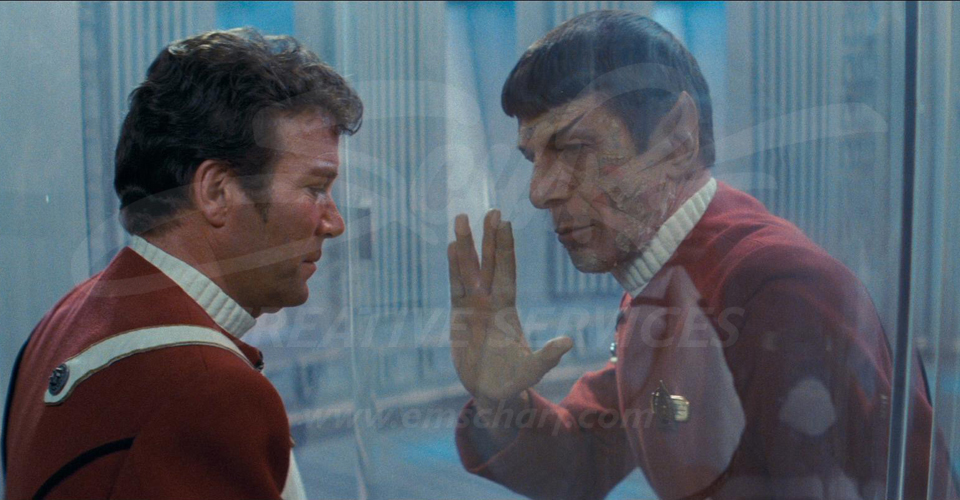
-
- ST2 provided an
excellent blend of action and drama. Khan was the perfect,
delightfully-familiar antagonist, providing painful and tantalizing back-and-forth with
Kirk. This film also included more prized exploration of Enterprise,
as well as other planetary locations. This film remains my personal
favorite of all the Star Trek films, including the latest effort.
Ricardo Montalban, may you rest in peace.

- “Star Trek III: The Search for Spock (ST3)”
begins where the previous film ends, with the Enterprise returning
to the nearest Starfleet starbase for what the crew expects to be a
near-complete overhaul. They arrive at starbase only to be
emotionally beaten down further when they discover Enterprise is set
be decommissioned. When McCoy begins behaving strangely, Kirk
receives a visit from Spock’s father, Sarek, revealing that McCoy’s
mind is carrying Spock’s Kattra or his living spirit. Kirk is denied
permission to take Enterprise after pleading with Starfleet command.
-
-

-
- Kirk successfully enlists his warn down senior staff to effectively
steal Enterprise away from the scrap heap for one more trip through
the cosmos to save a good friend and, possibly, another thought to
be lost forever. They head off towards Genesis, now a quarantined
planet. Before reaching Genesis, the science scout ship USS Grissom
is already orbiting Genesis, allowing Kirk’s son, David Marcus
(introduced in ST2), and
Lieutenant Saavik to study the planet and report their findings.
-
- The
report no one expected was that Genesis was created using unstable
proto-matter, which was used as a shortcut to please an impatient
Starfleet. A Klingon Bird of Prey, led by the maniacal Commander Kruge (played wonderfully by the usually comedic Christopher Lloyd),
has intercepted communications to Grissom.
-
-
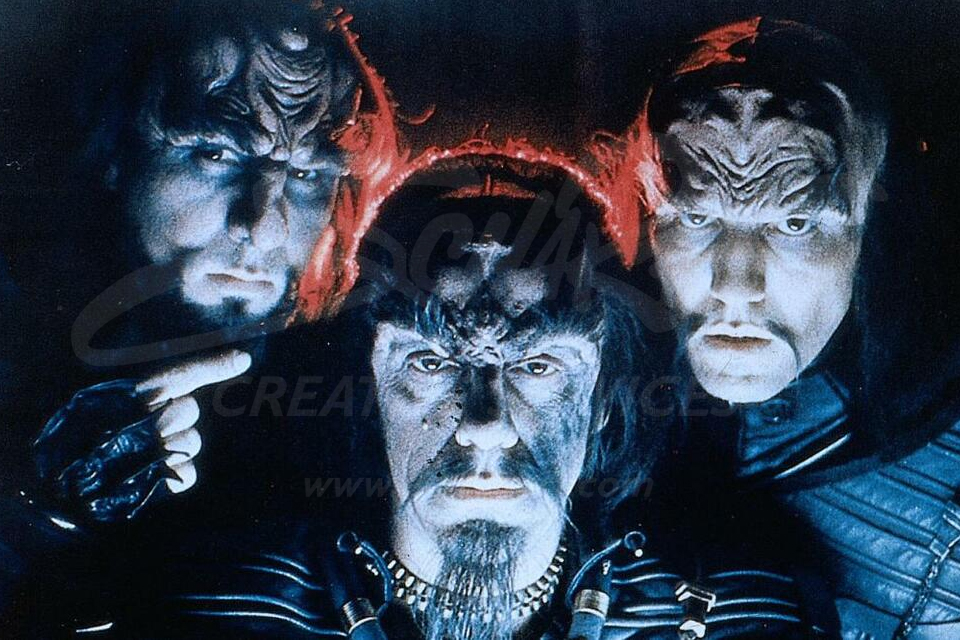
-
- Kruge destroys Grissom and plans on
stealing all Genesis data from the science team, despite the damning
report from David and unbeknownst to Kirk. The sputtering Enterprise
attempts and fails to fight off the Klingon ship, leaving Kirk and
crew as sitting ducks in space. David and Saavik discover a young
Spock and rescue him. The Klingons beam down to the planet to
intercept the science team and end up killing David.
-
-
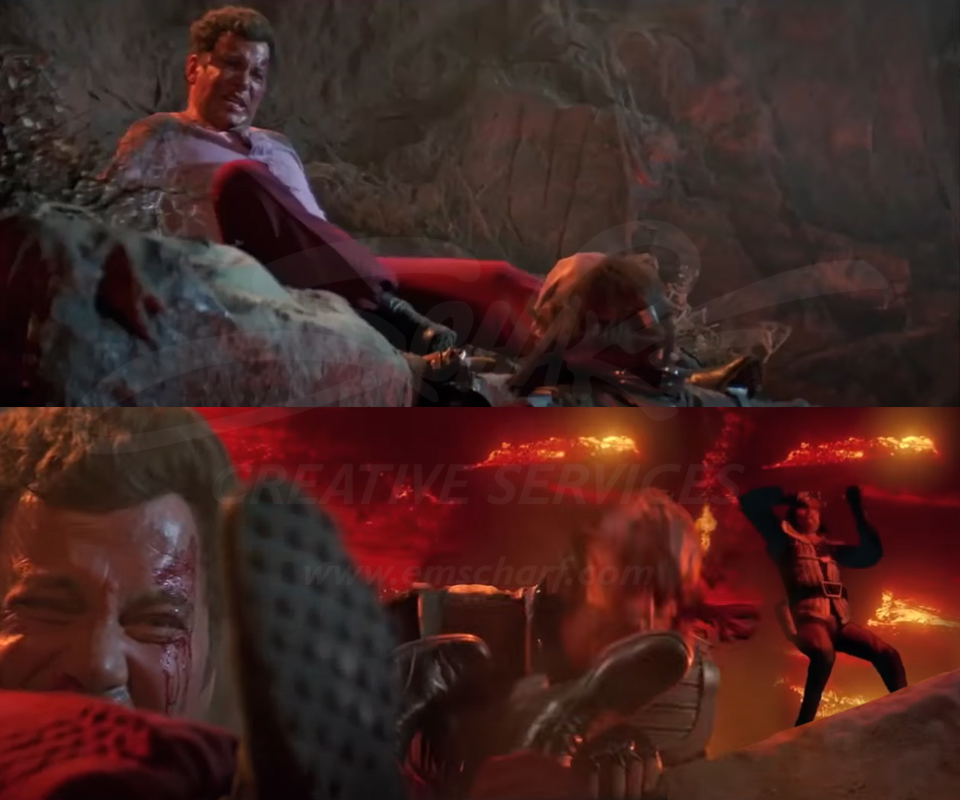
-
- Kirk wins an
exhausting hand-to-hand fight with Kruge, quite literally kicking
Kruge to the (lava covered) curb. Kirk rids himself of the remaining Klingons by fooling them into beaming over to a surrendered
Enterprise which is set to auto-destruct. He, then, does his best
Klingon language impersonation, telling the Klingon Bird of Prey to
beam two aboard, and Kirk conveniently manages to transport Spock off
of Genesis right as he conveniently achieves the same age as he was in
ST2. Kirk and company speed away from Genesis just before
it explodes.
-
- They head to Vulcan at best speed
for a “reunion” ceremony for Spock's body and his Kattra, as well as
the liberation of McCoy’s sanity.
-
-
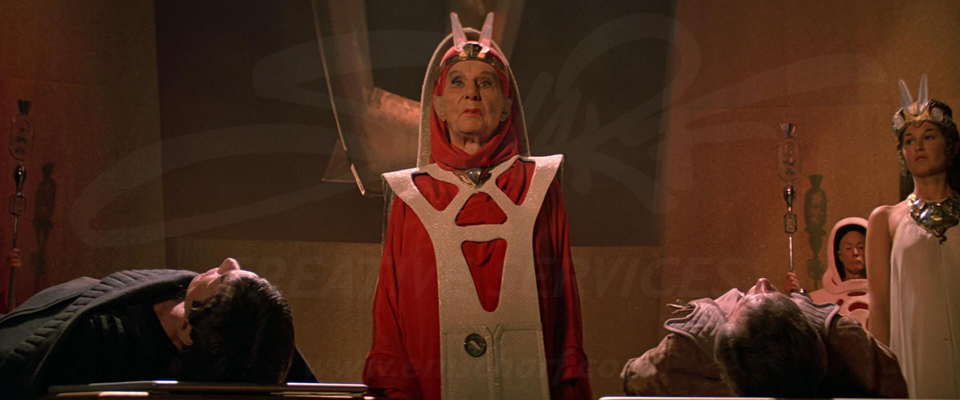
-
-
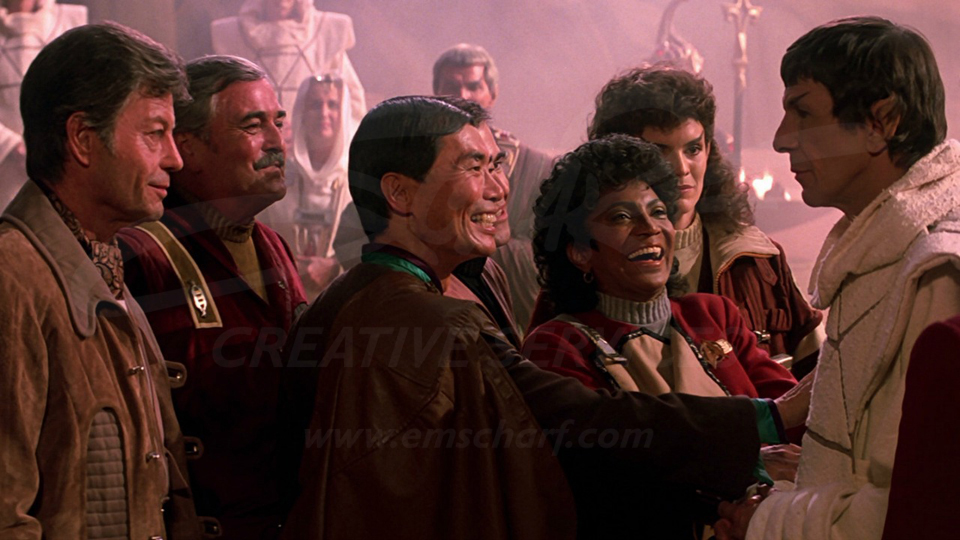
-
- This film was made with the best of intentions, and there
were dialogue-driven moments when it was actually enjoyable, but
Star Trek III was ultimately a letdown compared its predecessor
(which was produced for $4M LESS).
-
- Leonard Nimoy (in his directorial
debut) was not
quite as logical behind the camera as his alter ego has consistently been in
front of it. Even though Kirstie Alley's salary expectations
encouraged Nimoy to recast the role of Saavik, his selection of the
comparatively wooden Robin Curtis resulted in an unnecessary
departure from the character's previous portrayal. That aside, Nimoy is
no dummy, and one must wonder not if-and-when but how often
Paramount executives may have attempted to apply a Vulcan nerve
pinch to the choices of their rookie director.

- “Star Trek 4: The Voyage Home (ST4)” is
the final component of a three piece puzzle that began with ST2. Kirk and crew vote to leave Vulcan and return to Earth to
face their punishment for their actions in ST3. They leave
for Earth using the Klingon Bird of Prey they captured from Kruge at
Genesis. Dr. McCoy, grateful to be back to his old self and well
aware of the tribunal that awaits them back on Earth, has appropriately
painted the name "H.M.S. Bounty" on the ships hull.
-
- Meanwhile, a
probe, resembling a giant lacquered Lincoln Log (or a righteous
Tootsie Roll), is also on course
for Earth, radiating a slow-acting electromagnetic pulse or signal
that damages all manner of spacecraft and facilities in its path.
The same result and worse begins to take hold once the probe arrives
at Earth. The Bounty finally arrives in the solar system, receiving
broken transmissions from Starfleet, warning Kirk and crew to stay
away.
-
-
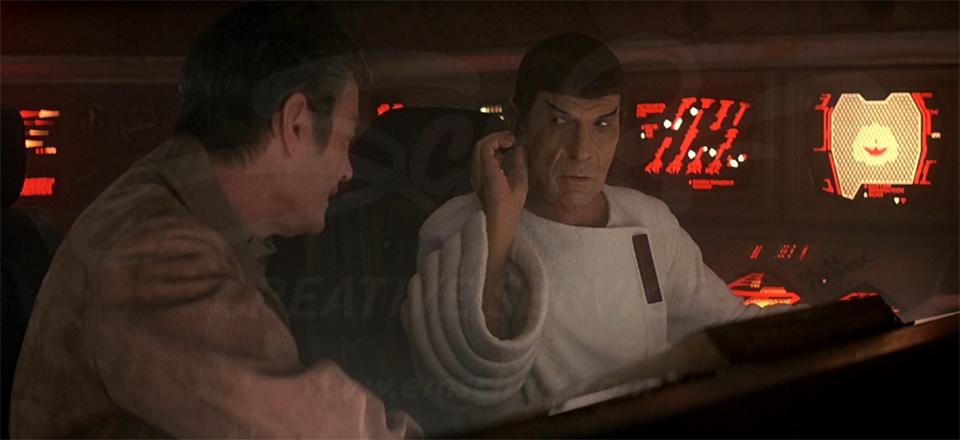
-
- Spock analyzes the signals of the probe and discovers they are
high-speed equivalents of whale song, in an attempt by the probe to
communicate with the long-extinct humpback whales. The crew decides to travel back in
time to acquire humpback whales, using a maneuver that will slingshot
them around the sun, causing a rip in time, and resulting with them reaching the 20th
century Earth, circa 1986. They detect two whales within the
vicinity of San Francisco. The wear and tear of time travel has
damaged the Bounty’s Dilithium crystals, nearly beyond repair.
-
- Their
mission from this point forward involves finding two whales (one
male, one female), retrofitting the Bounty with a custom-built tank
capable of holding several tons of water and the whales, finding a
large enough source of high-yield photons with which the Dilithium
crystals can be regenerated, and returning to the future just in
time to save the Earth, again.
-
-

-
- Kirk and crew succeed, but not before
waves of serious action, high drama, and zany entertainment ensue.
The entire crew gets an individual opportunity to shine in this film, and
they even pick up a new team member from Earth's past who is a valuable expert on their
precious cargo.
-
-
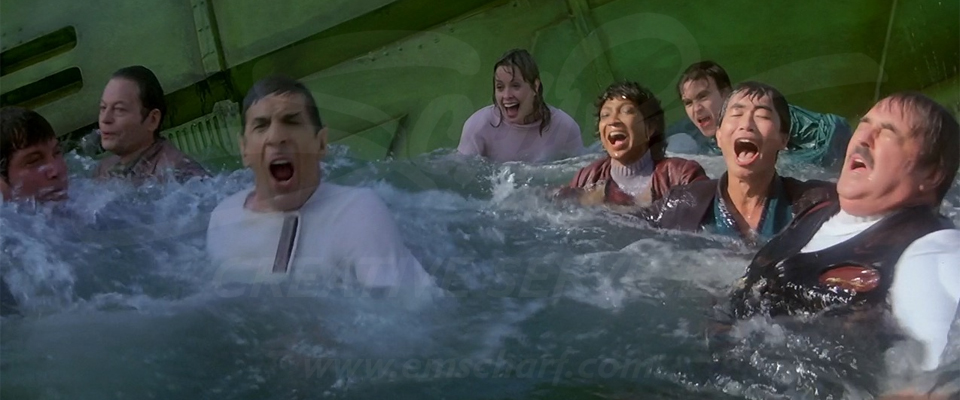
-
- For all of their effort, Kirk gets "demoted" from
desk-strapped Admiral to starship-sailing Captain of Enterprise.
Outside of Star Trek II, this film remains a personal favorite of
The Media Magnate, colorful metaphors and all.
-

-
- “Star Trek 5: The Final Frontier (ST5)”
began simply enough with Kirk and crew putting the latest version of
Enterprise through inspection, which it fails miserably. While the
ship is being worked over, Kirk et al enjoy some rare outdoor
shore leave in Yosemite along with some “Mission Impossible”
mountain scaling. Their therapeutic vacation is interrupted by an
emergency mission, using the same flawed Enterprise to rescue
several ambassadors who have been taken hostage and are being kept
on Nimbus III, the “Planet of Intergalactic Peace.”
-
- The culprit is Sybok, the previously unknown and mentally-unstable brother of
Spock. Starfleet takes the bait. Kirk and crew, however, are not
prepared for the army of low-rent villains Sybok has waiting for
them, and they fail in their bid to rescue the captives, who turn
out to be willing partners in Sybok’s bigger picture. Sybok’s
obsessive plan involves taking Enterprise and its captive crew on
his wild goose chase for the legendary planet Shaka-Ri, where life
began . . . and where God may be waiting.
-
- Upon reaching the planet, Sybok soon
realizes what was calling to him for so long was, in fact, a
powerful entity in need of a ship so that it can escape the planet.
Sybok’s final moments provide the most clarity he has enjoyed on
quite some time, as he goes through psychological battle with the
entity, holding it off until Kirk and crew can escape. The story had
promise and the film had a legitimate budget, but outside of Uhura
distracting the bad guys and dazzling fans with her naked sand dune
dance, the film did not work out, and The Media Magnate is being kind.
-
- William
Shatner is another personal favorite. His work on “Boston Legal” was
great, and his Tek War and Star Trek novels have quite a following,
too. Another favorite actor, Clint Eastwood, has been
known, as Dirty Harry, to say “a man’s got to know his limitations.”
The Media Magnate would say, “You do the math,” but anyone who is a Shatner fan
knows he is a perfectionist, and he had to have been under the
influence (of meddling studio executives) to deliver such an
all-around flat performance and potential franchise killer.
-
- A token bit of proof for The Media
Magnate's
conspiracy theory resides within the existence of the redesigned
phaser pistol with which Shatner was involved. He wanted it to
feel, weigh, and function more like a real gun, with a removable
ammunition / energy clip and all the trimmings.

-
-

-
-

-
- While it is possible to do such a
brilliant job of updating the "Star Trek" phaser pistol, and
completely blowing it on nearly everything else about ST5,
it is highly unlikely, again, that such a thing could occur without
"help" from Paramount. The Media Magnate is not a Shatner apologist
. . . just a
curious and thorough Star Trek fan.
-
-

-
- “Star Trek 6: The Undiscovered
Country (ST6)” was, for lack of a better phrase, a very nice recovery from
the previous film. The Federation and the Klingon Empire have been
enemies the greater part of a century. After the explosion of their
moon, Praxis, seriously jeopardizes the short-term survival of their
home world, the Klingons are forced to do something considered
uncommonly weak within the ranks of their overly masculine society.
-
- They ask for a peace treaty and aid from their sworn enemy, the
Federation. Kirk is, of course, dead set against a peace treaty with
a race he considers “animals.” He has never forgiven them for the
murder of his son, David, on Genesis. As if Kirk has not already had
enough adventure in his life, Starfleet “asks” him to escort Klingon
Chancellor Gorkon and his ship, Kronos One, to Earth for peace
talks.
-
- Gorkon’s ship, while en route, however, is attacked and
Gorkon is assassinated. Available evidence indicts the Enterprise as
the source of the attack and Kirk and McCoy as the assassins. They
are arrested, tried, and sentenced, by the always compassionate and
thorough Klingon High Council, to life on the frozen asteroid penal
colony, Rura Penthe. The icy prison also contains one of the most
important sources of precious Dilithium ore in the Klingon Empire.
-
- Spock is determined that his friends
and Enterprise have been framed. He enlists senior staff, as well as
Sulu, who is now captain of the Excelsior, and they urgently set out
to reveal the truth. Spock discovers an abnormally dangerous Klingon
Bird of Prey, commanded by Klingon General Chang, is capable of
firing when cloaked. Chang is responsible for firing on the
Chancellor, but the two assassins still, impossibly, came from
Enterprise. Kirk and McCoy are successfully rescued, and an
unbelievable conspiracy is exposed among Starfleet, Klingon, and Romulan officials who want to incite all-out war among their races.
-
- Enterprise and Excelsior defeat Chang, and Kirk and crew stop
another assassination attempt during the peace summit, all combining
to prevent a disastrous war and create a glimmer of hope for peace.
The only element which this film could have done without was the
3D close-up of the Klingon blood floating in zero gravity. Klingons
may be pre-historic in comparison to human beings, but is their
blood really the consistency of Raisinettes or Jell-O?

-
- “Star Trek: Generations (STG)” was . . .
different. It struggled between (unintentionally) projecting like an episode and
fulfilling the higher-priced duties of a feature film. The
idea of the energy ribbon (called "the Nexus"), its reality-bending capabilities, and how it involves
Kirk is interesting, but other elements of the story are either half-baked or too
over the top.
-
- As a fan who always wants the best for the captain and
crew of the Enterprise, The Media Magnate was fanboy-frustrated with
Kirk's sacrificial end, even though (being the savior he often was) he saved Picard. No matter how many times he cheated death,
Kirk may have deserved
a better end, perhaps a return trip to the Nexus. Still, he heroically
exited with his usual “c'est la vie.”

-
- “Star Trek: First Contact (STFC)” was more
like it, breaking the bonds of ultra sterility that occasionally
plagued the Next Generation crew. The Media Magnate has always enjoyed Patrick
Stewart’s effort as Jean Luc Picard, but the character’s stoic,
brooding manner seemed a bit wasted until THIS film. He and his
entire crew are faced with their own mortality in a do-or-die
scenario. The prime directive is no longer in play, and they must fight dirty against a Borg collective determined to
complete their future-warping mission at all costs.
-
- This film also includes more of
the interior and exterior exploration of the Starship Enterprise. The Media Magnate particularly
enjoyed the scene where Picard, Warf, and Lieutenant Hawk used
magnetized space suits to traverse the underside of the Enterprise’s
saucer section in order to stop the Borg from converting the
communications array for their own evil purposes.

-
- “Star Trek: Insurrection (STI),” from
start to finish was another film struggling to elevate from episode
status to that of a feature film, even with the record (for Star
Trek films) $58 million dollar budget. The Media Magnate has nothing against
Jonathan Frakes, the actor or the director, especially after he
delivered such a memorable effort with “Star Trek: First Contact.” And, yet,
there was no (budgetary) excuse for the unimaginative visual effects,
accentuated by the episode-quality robot probes.
-
- The story had
promise but quickly eroded into a one-pager that could have fit
nicely into an episode. A banished and deteriorating part of a
peaceful alien society wants to return to the fold by stealing their
homeworld and turning it into an intergalactic fountain of youth.
The medicinal cosmic radiation emitted by the planet would prevent
the outcasts from requiring any further dermabrasions.

- “Star Trek: Nemesis (STN)” actually felt
like a feature film, but it provided the worst box office
performance of any Star Trek film to date. Yes, it had some stiff
competition from Harry Potter and James Bond during its debut
weekend. There are some promising story components, involving a
literal Picard clone as the new peaceful Shinzon of the Romulan
Empire and their little known slave subculture, the Remans. There
are also a few good action sequences as well, especially with the
heavily-armored Reman Warbird Scimitar. It all comes crumbling down,
however, with some weak story links and plot holes, as well as
a brief cameo by none other than Vice Admiral Janeway.
While it is clear that “Star Trek” has lived long, it
has not always prospered, even with an incredibly loyal following.
The never-ending challenge of making the next television series or
film into a perfect compliment to the original, or even better than
the original, however, keeps most defiant directors and hopeful
Trekkies coming back for more, again and again.
The Latest Attempt

- It is now Stardate 2009, and “Star
Trek” fans, as well as a defiant director by the name of J.J.
Abrams, have gotten their wish with the introduction of that latest
feature film, simply entitled “Star Trek.”
Depending upon your perspective as a curious mainstream filmgoer, a
casual science fiction fan, or a hardcore Trekkie, the title could
easily have been either (A) “Tradition is for The Birds,” (B) “If at
First You Do Not Succeed, Try, Try, Again,” or (C) “Beware to Those
Who Wish to Rewrite History.”
All three phrases apply but it appears that finally, at long last,
someone in J.J. Abrams has, in baseball terms, stepped up to the
plate and hit a home run, a long triple, or a stand-up double. The
Media Magnate self-identifies as a moderate Trekkie who simply has yet to attend or
dress the part for any “Star Trek” conventions. Abrams hit a risky inside-the-park home run with a number of threads
missing from the baseball and some nagging splinters sticking out of
the bat (all of which The Media Magnate will touch upon through a breakdown of key
cast members and the plot).
The Cast
Abrams made some interesting choices, from relative unknowns to
popular film and television personalities to long-time silver screen
veterans, when filling out the world famous crew of the Enterprise
and other memorable characters from the new cast.
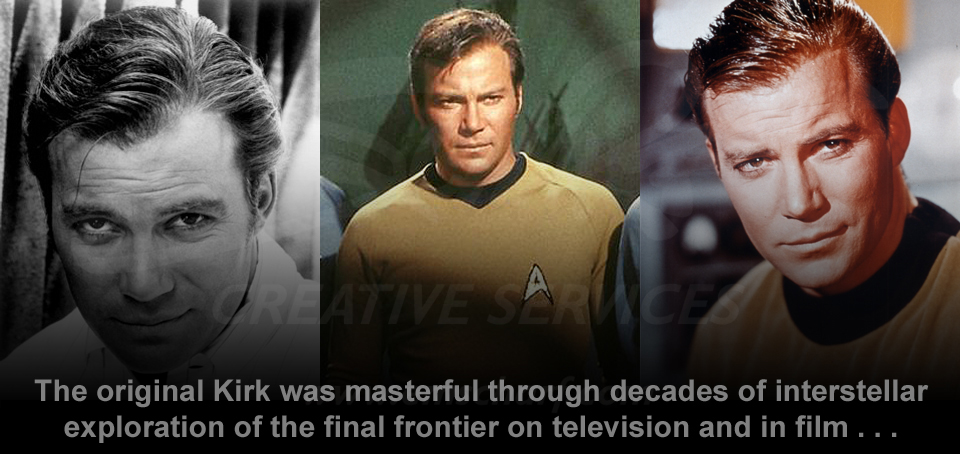
-
-
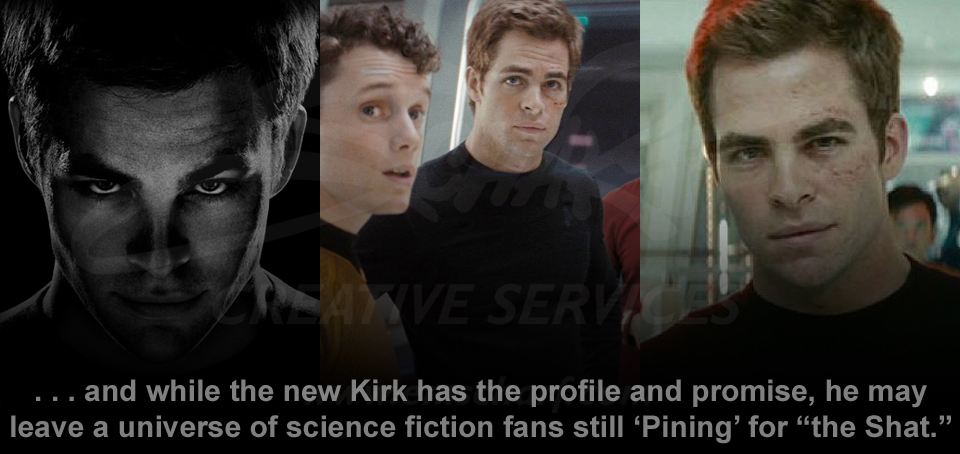
-
- James T. Kirk is played by Chris
Pine. The Media Magnate is unfamiliar with almost all of his previous acting roles,
outside of “Smokin’ Aces,” and his work with Lindsay Lohan in “Just
My Luck” cannot have been a high point in his career. While the ultra-flippant (not overacted) edge he has
added to Kirk’s character is appropriately alien to fans, Pine displays
a nice emotional range.
-
- The Media Magnate does not mind that Pine decided against
mimicking Shatner’s speech patterns (because he would have been
bashed mercilessly had he done a poor job of it). Kirk, after all, is
one of “Star Trek’s” six sacred cows, and there is very little
wiggle room within a role that was built on a specific personality
just as much as anything else. Pine’s version of Kirk could grow on
fans as long as he continues to become more like Kirk, in the next
film, and a little less like Jason Nesmith of “Galaxy Quest.”

-
-
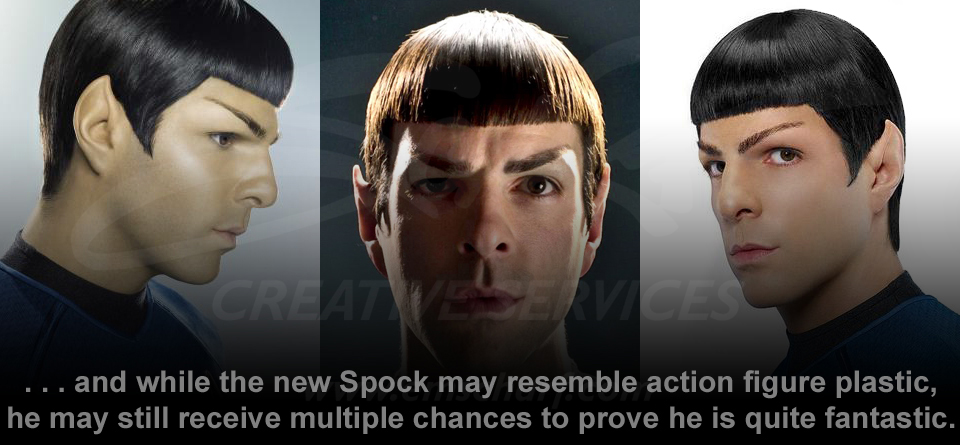
-
- Spock is played by Zachary Quinto,
who joins Starfleet fresh off the third season of the critically
acclaimed network television series, “Heroes,” in the role of the
similarly yet cryptically “controlled” Sylar. Quinto shows promise
as everyone’s favorite “green-blooded, inhuman” Vulcan, and in all
fairness, he has been asked to portray Spock with a bit more
humanity than “normal.” As with Chris Pine and his critical
portrayal of Kirk, it will take some time to get used to seeing a
new, younger face don the pointy ears and jet black bowl cut.
-
- Leonard Nimoy at a similar age possessed a longer face and a
slightly more slender build, as well as a noticeably deeper voice. Watching footage of Spock for such a long time makes you
cherish details as more than just details. Nonetheless, The Media
Magnate is
interested in seeing Quinto reprise his new role alongside Pine,
developing and hopefully putting a good stamp on a famous friendship
known throughout the galaxy.

-
- Spock Prime is played by Leonard
Nimoy who, even in his elder status, has not lost a step. ‘Nuff
said.

-
- Nero is played by Eric Bana, who
does a fine job as the understandably disturbed Romulan seeking the
ultimate-if-misguided revenge for the deaths of his family and his race. What
should not go unnoticed, however, is the incredible makeup job for
Nero. Bana, with respect, has ears similar to Alfred E. Newman (of "MAD Magazine"
lore for the younger readers in the audience). The makeup
artists for “Star Trek” essentially pinned back Bana’s ears with the
combination of the fake Romulan ears and the bulky latex covering on
his head.
-
- The Media Magnate honestly did not recognize
Bana until about 30 minutes
into the film (after hearing his voice once or twice). Bana's effort
can be added to the list of his other well-received roles (in “Black Hawk Down,” the
underappreciated “Hulk,” the much-maligned “Troy,” and the chilling
“Munich”). His voice acting in “Finding Nemo” was hilarious, as well.
-
- Nero is the first role, if memory
serves, where Bana
plays not only a bad guy, but THE bad guy. While not completely sold on
former-comedian Bana as
leading funny man material, he has a fan in The Media Magnate for any serious roles he
chooses (director, script, co-stars, and budget notwithstanding, of
course).
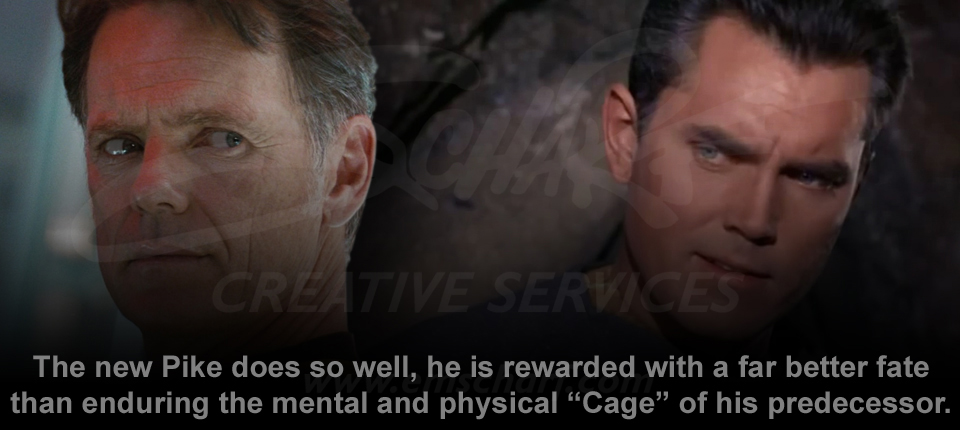
-
- Captain Christopher Pike is played by Bruce Greenwood, one of the
most-established Hollywood veterans on the cast. He is as folksy,
relaxed, and confident as The Media Magnate remembers the original Captain Pike,
played by Jeffrey Hunter, from
the first “Star Trek” television series. Greenwood accomplishes his
mission in fine fashion.
-
- He is also one of a dying breed of quality
actor who can play a variety of roles, both good and bad, for film
and television. The Media Magnate enjoyed his parts in “Double Jeopardy,” “Rules of
Engagement,” “The Core,” “I, Robot,” and “National Treasure: Book of
Secrets.” While he may not be in the acting chameleon class of
Robert De Niro, Greenwood just seems to be able to take almost any
role and be more than effective. The Media Magnate eagerly
anticipates Greenwood’s next
offering.
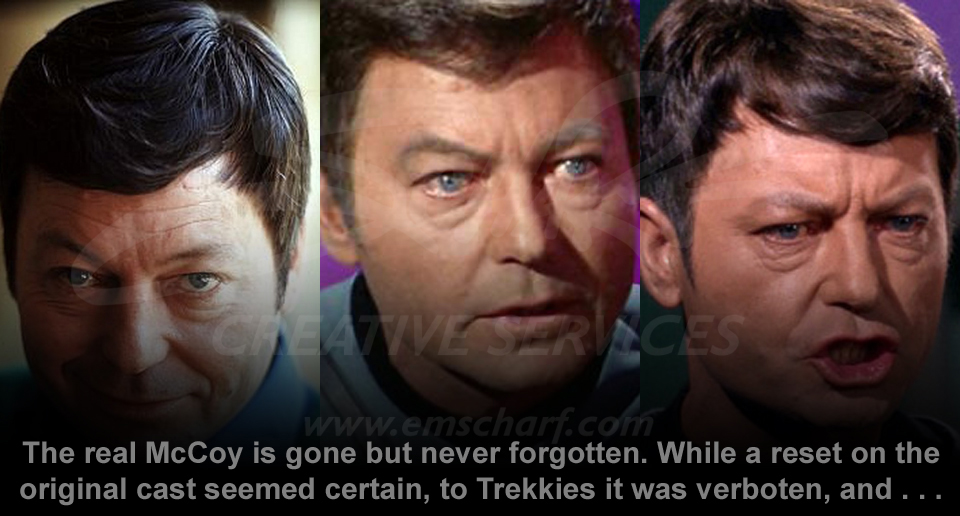
-
-
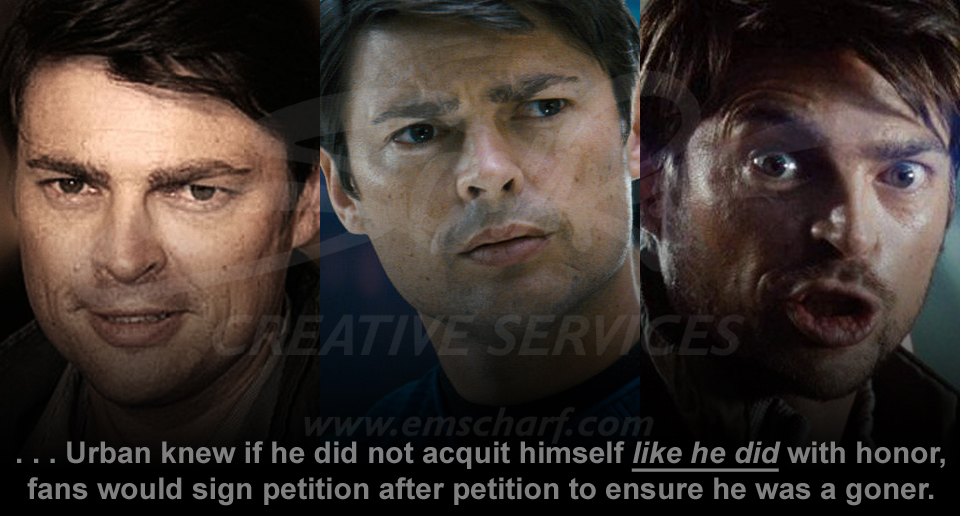
-
- Dr. Leonard “Bones” McCoy is played
by Karl Urban, and he does a splendid job as the no-nonsense, often
irritated, rarely inaccurate doctor of the Enterprise. While Urban’s
likeness to Bones is not perfect, it is completely unnecessary,
because Urban has all of the mannerisms down like they were his own.
-
- The Media Magnate already liked him
from “The Lord of the Rings” films, “The Chronicles of Riddick,” and
“The Bourne Supremacy,” but if he returns as Bones for several more
“Star Trek” films, Paramount can count on THIS movie reviewer to buy a ticket every time. What a joy to watch, and if
the original was still alive today, The Media Magnate believes he
might just agree. DeForest Kelley - may you rest in peace.
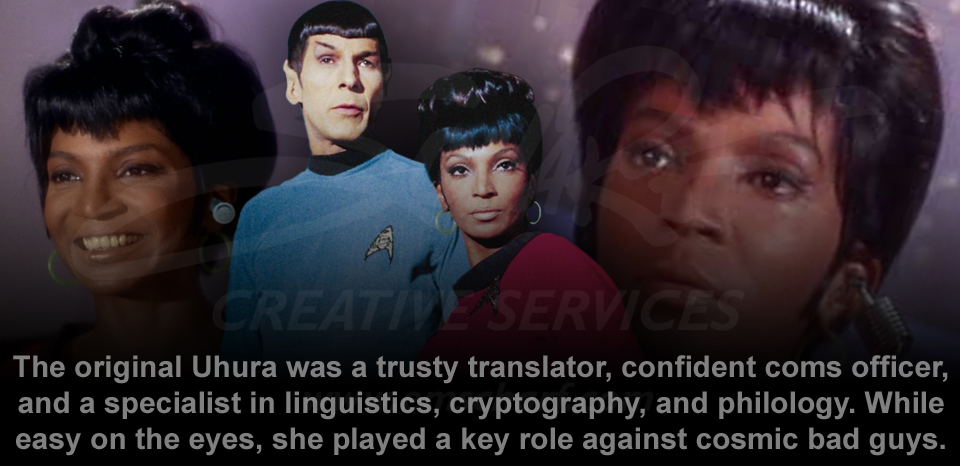
-
-
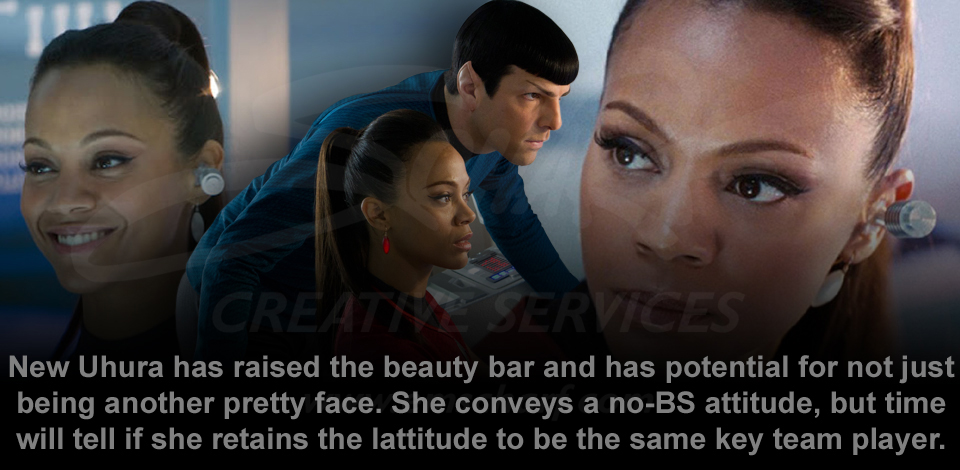
-
- Nyota Uhura is played by Zoe
Saldana. She is extremely attractive, she is in the oddest
relationship pairing this “Star Trek” film can offer, and she
adequately fills the role of Uhura, with a fresh touch of attitude.
The Media Magnate thinks she is capable of much more, but she does not write the script.

-
- Montgomery “Scotty” Scott is played by Simon Pegg, from equally
well-known films “Sean of the Dead” and “Hot Fuzz.” The Media
Magnate knows little
about Pegg, outside of those two films, but from what has been seen of
him, including his time as chief engineer of the Enterprise, he
seems more than capable of honorably filling James Doohan’s shoes
with a fresh approach to boot.
-
- It will be up to Abrams, or whoever
helms the next film, however, to determine if Scotty will remain so
squirrely (from being pent up in a Starfleet outpost) or will
eventually calm down into the confident chief engineer we all know
and love. And The Media Magnate will not be upset if the new Scotty proves unable to
hold his liquor as well as the original, as starships need engineers who are in complete
command of their faculties 24-7. James Doohan - may you rest
in peace.
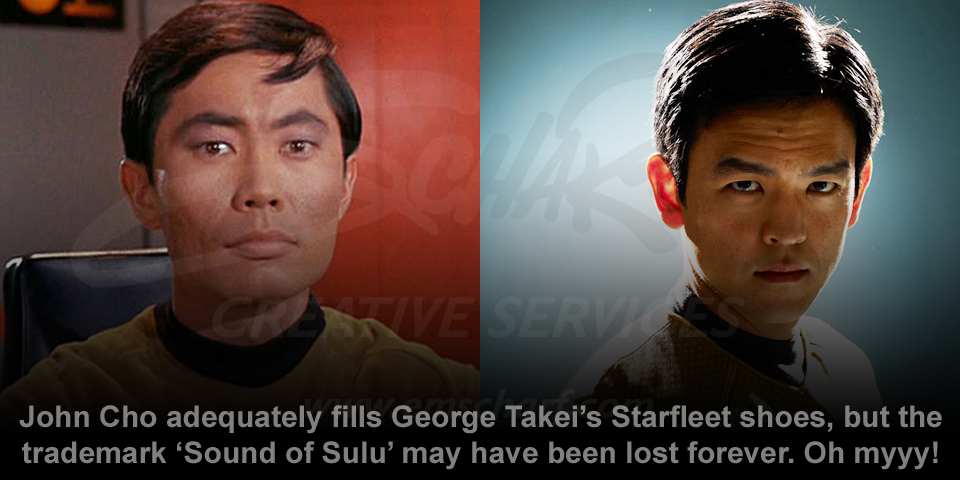
-
- Hikaru Sulu is played by John Cho, otherwise known as the
"American Pie" MILF guy
or the "White Castle" guy. The first reference always makes me laugh,
and the second makes me want to vomit. Still, other “Star Trek”
fans, particularly Trekkies, wanted to vomit because Cho is a
Korean-American rather than a Japanese-American.
-
- The Media Magnate is aligned with
George Takei, who recalled Rodenberry wanting Sulu to represent all
Asians, not just Japanese. Midwestern nutritional requirements and
cultural representations notwithstanding, Cho can obviously act, and
he performs well in “Star Trek.” Time will tell, however, whether or
not he can survive and thrive long-term in serious roles such as
that of Hikaru Sulu.
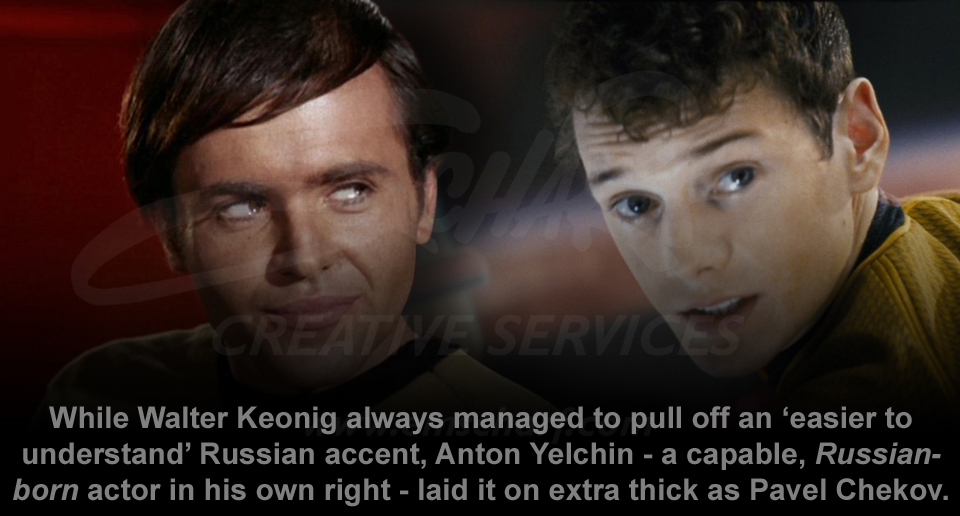
-
- Pavel Chekov is played by
Leningrad-born, Russian-American Anton Yelchin (who also played young Kyle
Reese in the recently-released “Terminator Salvation”). While The
Media Magnate believes Yelchin is an up-and-coming star with
potentially unlimited talent, and though his general portrayal of Chekov was
promising, his accent was enough to suffocate the entire audience.
-
- It was one thing to hear
Walter Koenig struggle, in “Star Trek 4: The Voyage Home,” to ask a
San Francisco police officer “Where are the nuclear vessels in
Alameda?” The Media Magnate cried laughing the entire time, every
time. It was entirely another
thing for Yelchin to quite literally suffocate fans with every one
of his lines.
Sarek is played by Ben Cross, a world-renown actor who has,
literally, played every part imaginable in an ever-widening range of
film and television properties, from “Chariots of Fire” to “Dark
Shadows” to “20,000 Leagues Under the Sea.” Speaking of which, he
has even performed for everyone’s favorite television network, the
SCIFI Channel. Abrams could have done far, far worse than Ben Cross
as the next in line to play Sarek, and The Media Magnate hopes to see much more of
him in this role.
Amanda Grayson is played by Winona Ryder, whom everyone knows, more
for her theft of material goods than for her acting thievery of
powerful scenes from formidable co-stars in the various films over
the course of her career. In any event, Ryder played her bit part
well.
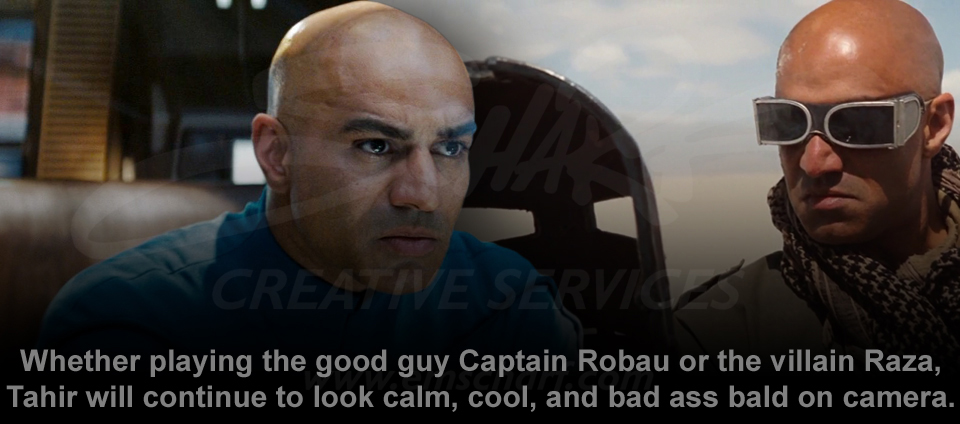
-
- Captain Robau is played by Faran Tahir
(a quality actor who also portrayed the lead terrorist responsible for kidnapping Tony Stark
in "Iron Man").
While Tahir plays a brief part, he is believable as a good guy with
the strong, commanding presence required of a Starfleet captain. The
Media Magnate
hope's to see him in more and greater roles for either type of
character in the future.
The Media Magnate has always been impressed with actors who can seamlessly play
both good guy and bad guy roles. It is one thing to have one lead or
supporting actor in a film being so capable, but four?! Bravo to
Abrams for landing Bana, Greenwood, Urban, AND Tahir . . . with
excellent results.
The Plot
The plot involves an accelerated supernova that is endangering the
Romulan homeworld of Romulus. The Vulcans agree to help their
estranged and emotionally-driven brethren by having Ambassador Spock
(herein referred to as Spock Prime) fly towards the supernova with a
specially-designed ship, containing Vulcan-engineered "red matter.”
Spock Prime would fire several containers of red matter into the
supernova, creating an artificial black hole to collapse and consume
the erratic star. The Vulcans feverishly follow through on their plan, but the supernova
exhales its final breath sooner than expected, destroying Romulus.
-
- Captain Nero, of the
enormous Romulan mining ship Narada, goes out of his mind at the
sight of his homeworld being destroyed, along with his wife and
unborn child. He naturally blames everything on the passionless
(emotionally-controlled) Vulcans, particularly Spock Prime, for the needless destruction of
his very civilization. Everyone on Vulcan presumably knows that if Spock
fails to save Romulus, even if it is clearly not his fault to any
witnesses on the interstellar periphery of the cataclysmic event, every remaining Romulan in
the galaxy will spend the rest of their days trying to exact
zealot-level revenge against him and the entire Vulcan race. Before Nero can attempt to
have vengeance, both of their ships are caught in the resultant
black hole, traveling to completely different periods in the past.
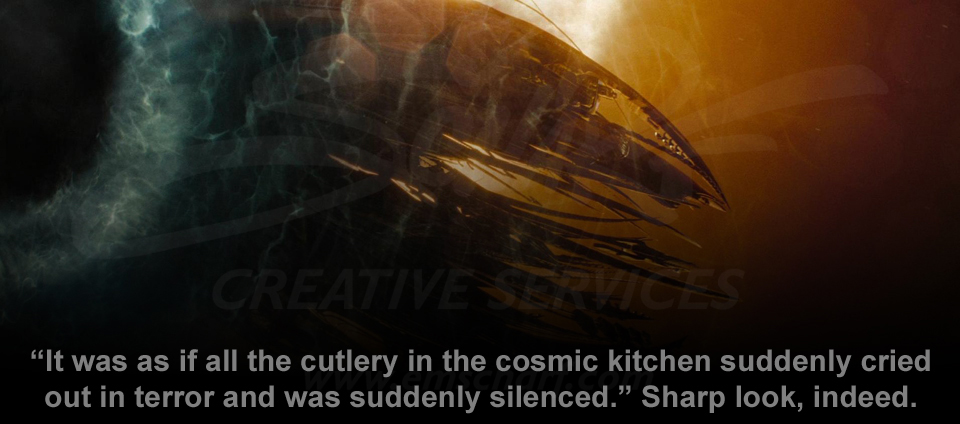
-
- As a design aside, the Narada has some minor,
unintentional similarities to the Reman Warbird
Scimitar, at full extension, in “Star Trek: Nemesis.” The Narada, by
comparison, is also an asymmetric, organic-looking mess. The
Narada's advanced weaponry and unique appearance (according to the
four-issue comic book prequel "Star Trek: Countdown") are described
as a modification from salvaged and reverse-engineered Borg
technology.
Nontheless, the Narada exits the black hole first, more than a
century-and-a-half earlier, and attacks the much smaller Federation
starship USS Kelvin. Nero ceases fire and “requests” the presence of
the Kelvin’s commanding officer, Captain Robau, in order to discuss
terms of surrender.
Robau makes George Kirk acting Captain of the Kelvin in his
absence. When it appears an understandably confused Robau is withholding the whereabouts of
Spock Prime, Nero kills Robau. Nero’s blood lust overshadows the
fact that Spock Prime does not yet exist in the current timeline (as
a long-recognized Starfleet officer).
Kirk takes command upon learning of Robau’s demise and
orders an immediate evacuation of all personnel. Kirk mans the
bridge, providing cover fire until all personnel have safely left
the Kelvin via shuttle craft.
-
-
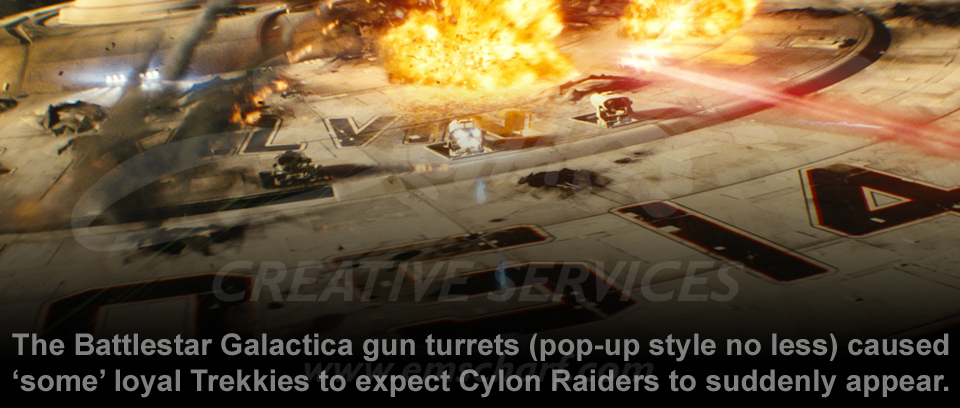
-
- As a design aside, the pop-up rail guns on the Kelvin
are a curious choice, belonging more to the recently
re-imagined-and-concluded SciFi Channel original series, "Battlestar
Galactica" (to which a good friend refers as “The Travesty”). The
single warp engine for the Kelvin is also a bit confusing, as
fictional rumor has it that dual engines are required for achieving
warp speed.
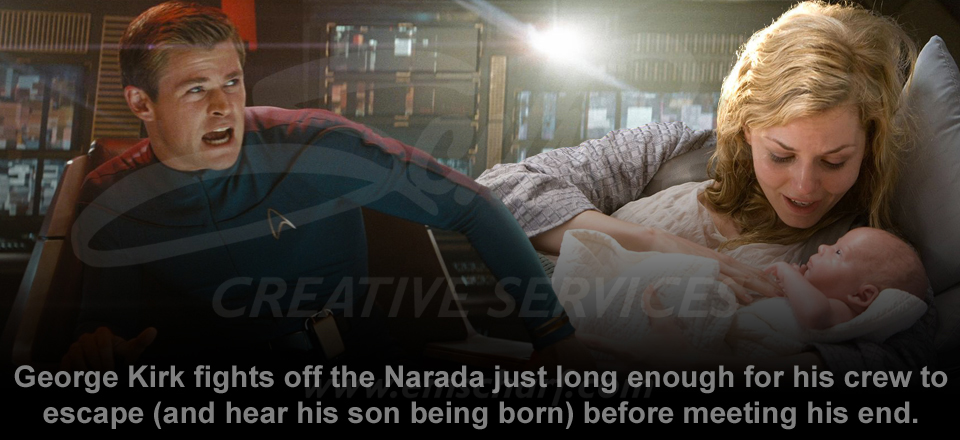
-
- The Kelvin’s autopilot and self-destruct capabilities have been
irreversibly damaged, and Kirk must remain aboard the Kelvin for a suicide collision with the Narada. He completes his
mission just moments after speaking with his wife, Winona, and
hearing the voice of his new born son, James Tiberius Kirk, aboard
the last of the shuttle craft.
Spock Prime finally exits the black hole a couple decades later only
to be captured on the spot by Nero. He confiscates Spock Prime’s
ship and leaves him for dead on the planet Delta Vega so that he can
helplessly watch as the very same red matter he brought to save
Romulus is used to destroy his own homeworld of Vulcan.
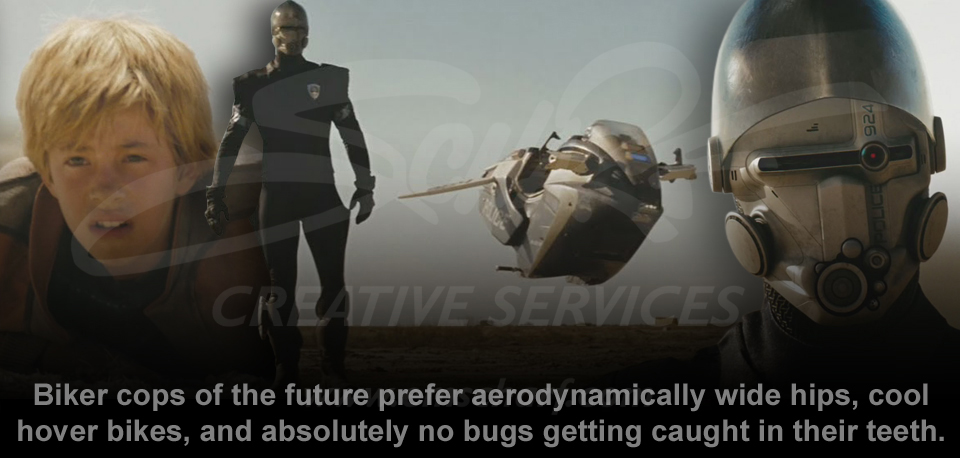
-
- Meanwhile, James T. Kirk has developed
from a defiant, thrill-seeking boy into a bright-yet-still-cocky young
man with a tremendous chip on his shoulder towards authority
figures. He crosses paths for the first time with Uhura (before) and
Captain Christopher Pike (after) a bar fight which ends poorly for
Kirk.
-
- Pike shares with Kirk his own father's story of heroism, and he
dares Kirk to do better that the elder George by joining Starfleet. Kirk greets Pike’s
challenge with cynicism, but he nonetheless arrives on time at the rendezvous
coordinates (like a curious cat compelled to investigate further).
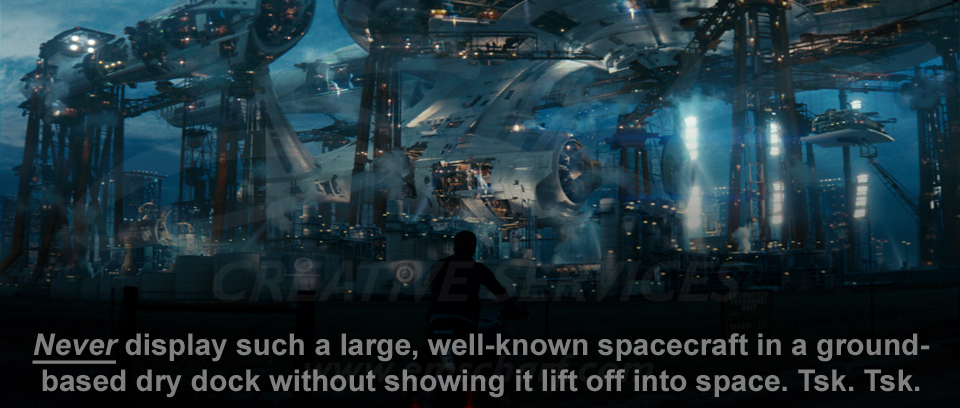
-
-

-
-
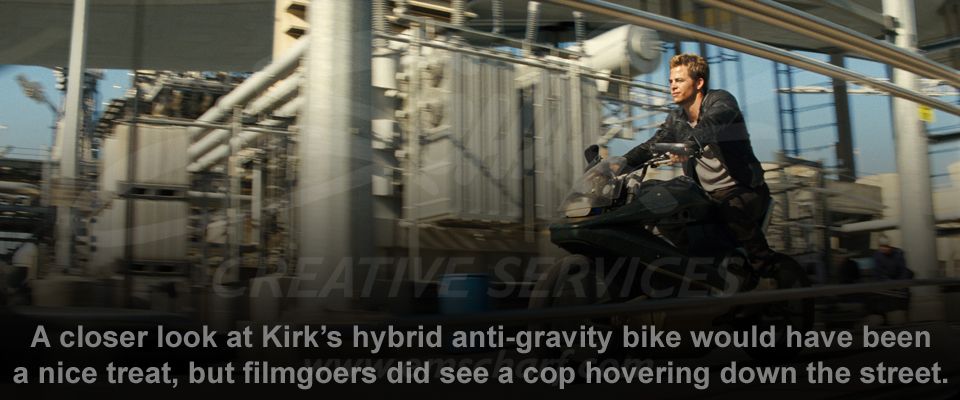
-
- As a design aside, Kirk's mode of transportation is a
seemingly-outmoded
2-wheel electro-magnetic motorcycle. It has a chassis and two wheels
that have no forks, mags, or gears. They are, in fact, hollowed out
and the chassis is presumably held into position by one or more
anti-gravity units. Even though the modern-mechanical hybrid is a poor
cadet’s version of what
the police officer was riding in the earlier chase scene, The Media
Magnate would have appreciated a close up of Kirk’s bad boy bike.
After essentially gifting his bike to one of the security
guards, Kirk boards a shuttle craft, meeting Leonard McCoy, in all
of his often-irritated glory. Thus begins their "long strange trip"
to Starfleet Academy and far beyond into the deepest reaches of
space.

-
- Kirk, for his unpredictable mix of
potential greatness and reckless abandon, has survived through his
third year at Starfleet Academy. After shockingly passing the often
feared but never conquered Kobayashi Maru test, Kirk is accused of
cheating by the program's designer, Commander Spock. Kirk’s
interpretation of the test is that a no-win scenario is not real,
therefore, his solution did not involve cheating. Spock insists the
no-win scenario upon which the test is based is real, because you
must be able to maintain your leadership skills and self-control,
for your crew, even in the face of certain death.

-
- A contentious court hearing on the
matter is suddenly interrupted by an urgent distress call from Vulcan indicating the appearance of a
lightning storm in space. All cadets are scrambled and receive their
starship assignments save one: the grounded James T. Kirk. McCoy (after
much handwringing) decides to break the rules by injecting Kirk with
an easily curable alien flu-of-sorts. McCoy (due to the
suddenly-pliable commandments of the Hippocratic Oath) places Kirk
"under his care," creating just the excuse to bring him aboard the
brand new Enterprise.
As a design aside, Industrial Light & Magic (ILM) did an excellent job of blending live action
footage with CG of the shuttle craft taking flight and
heading towards Enterprise, displaying the cadets looking through
their portals at the huge starship and the far more massive starbase.
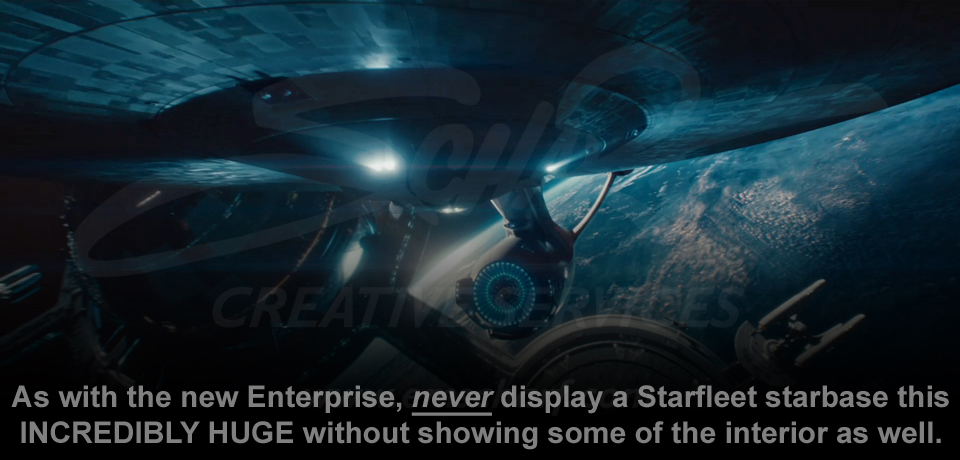
-
-
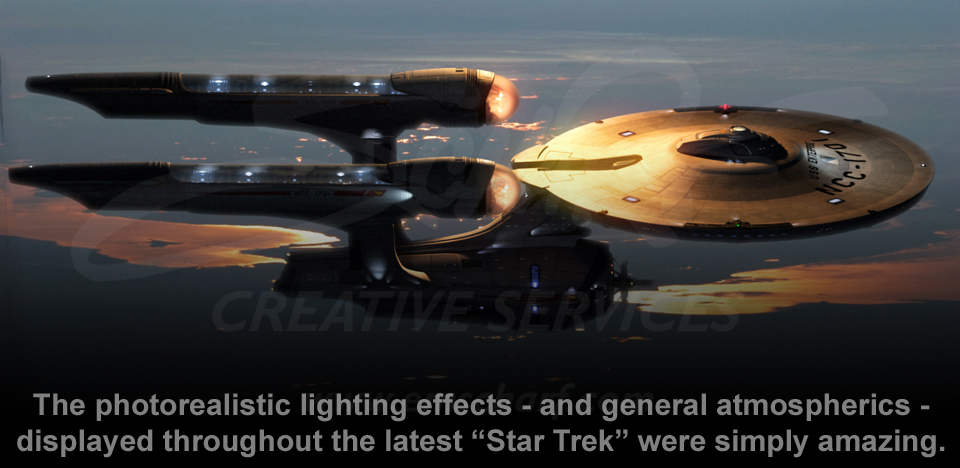
-
-

-
-
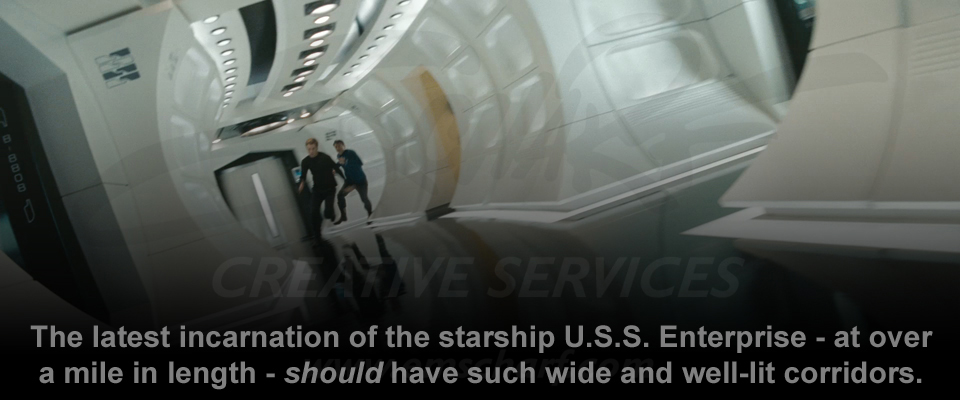
-
- Kirk (and after the ridiculously
swollen side effects of the alien flu have subsided) claims to recognize the
spatial anomaly as similar to the one that devastated the USS Kelvin ended his father’s life.
He pleads with Pike (to no avail) not to follow the fleet into what he believes is
a certain trap. The Enterprise arrives on the unexpected scene of a
floating graveyard of destroyed Federation starships (for which they
must suddenly perform unreasonably evasive maneuvers to avoid a
quick end to their plan).
The Narada is using a huge laser drill to reach Vulcan's core.
Nero, as is his ritual, orders Pike to board the Narada via
shuttlecraft to discuss terms of surrender. Pike obliges (wisely
acknowledging the sample of Nero's treachery in loose orbit around
Vulcan). Pike promotes Spock to captain and Kirk to first
officer as he leaves the bridge.
Before arriving at the Narada, Pike instructs Kirk, Sulu, and Chief
Engineer Olson, to perform an orbital skydive onto Nero’s drilling
platform to destroy it before the platform's laser reaches Vulcan’s
core.
-
- As a design aside, the next scene
where all three drop out of Pike’s shuttle craft reminds The Media
Magnate of a mildly-similar scene, from “Reign of Fire” (with the Arch Angels jumping from a
military chopper with the mission of taking down a dragon on their
way to the ground).

-
-
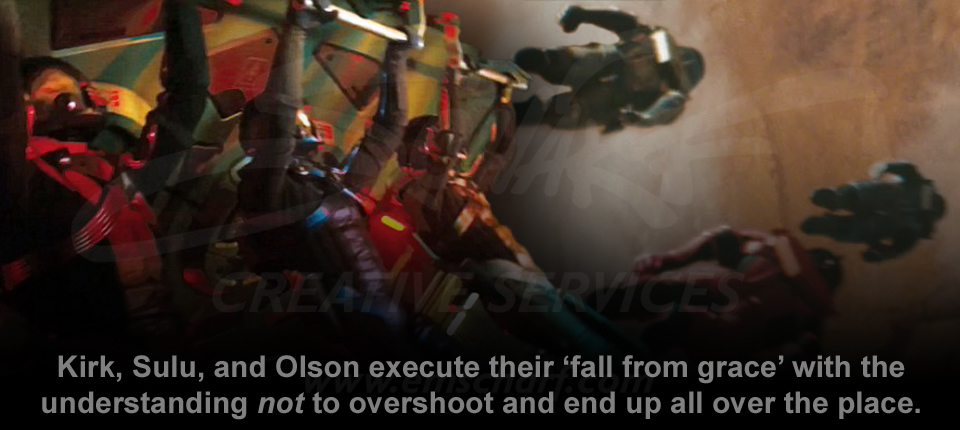
-
-
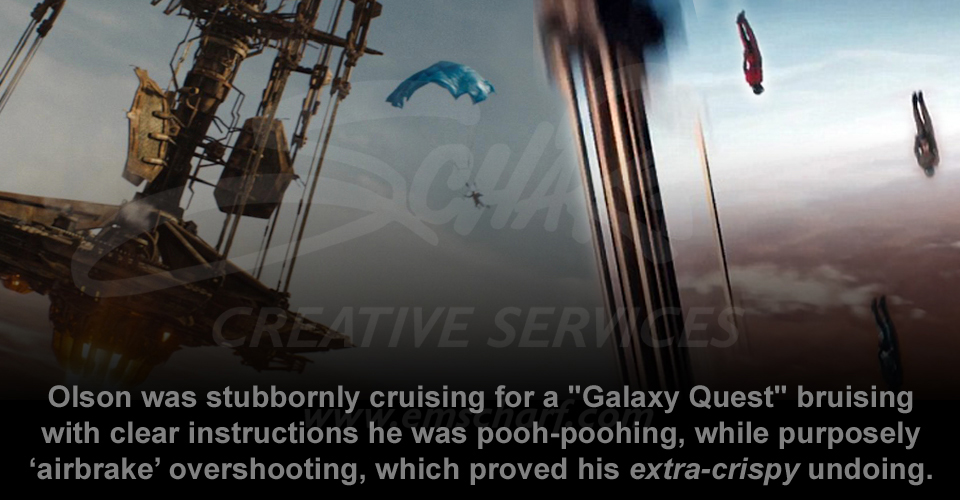
-
-

-
-

-
-
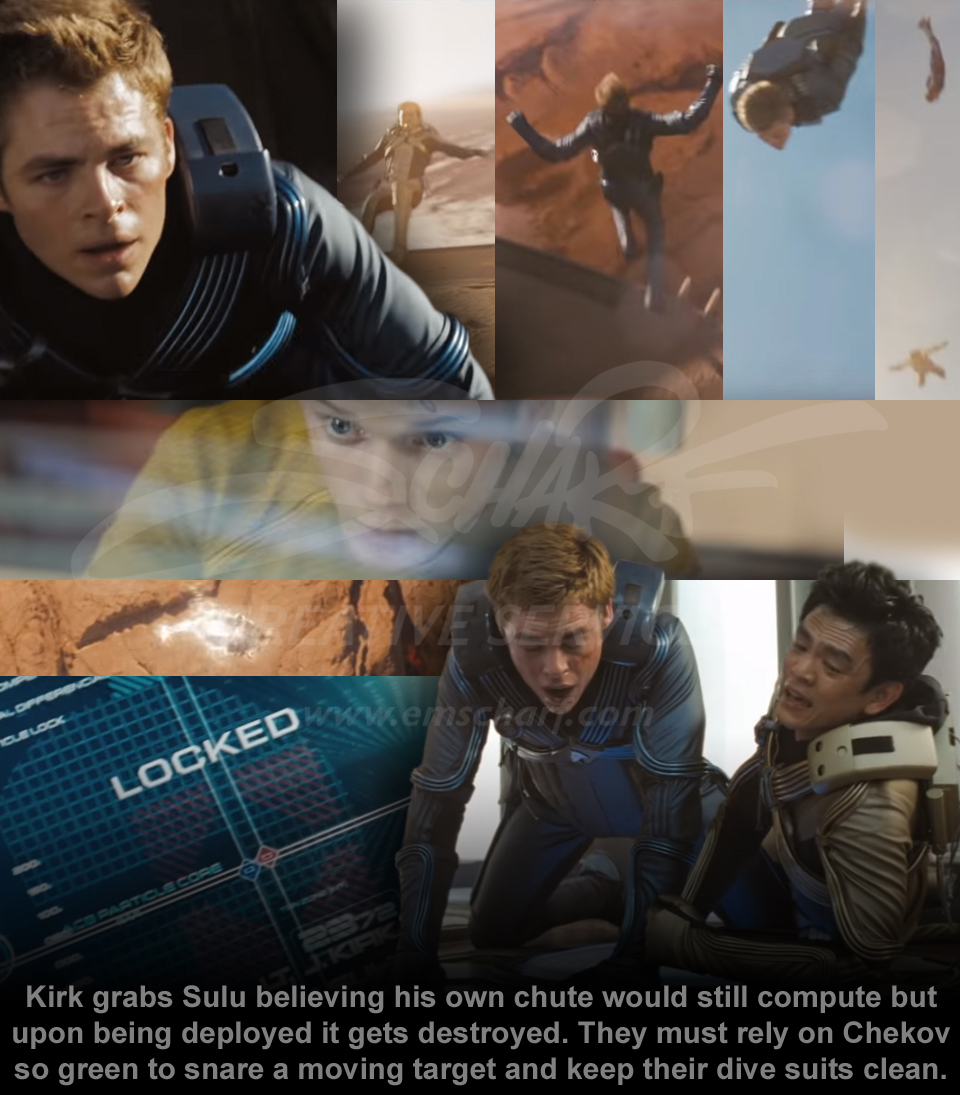
-
- Upon disabling the drill, the signal
frequencies for communications and the transporter room are no
longer jammed. The drill has reached the necessary depth, however, for Nero to
fire a single drop of the red matter into Vulcan’s core, with the
homicidal goal of collapsing the planet into a
black hole.
Acting Captain Spock beams down to Vulcan and rescues most of the
planet's elders, including his father, Sarek, but his mother, Amanda
Grayson, parishes along with most of Vulcan’s inhabitants.
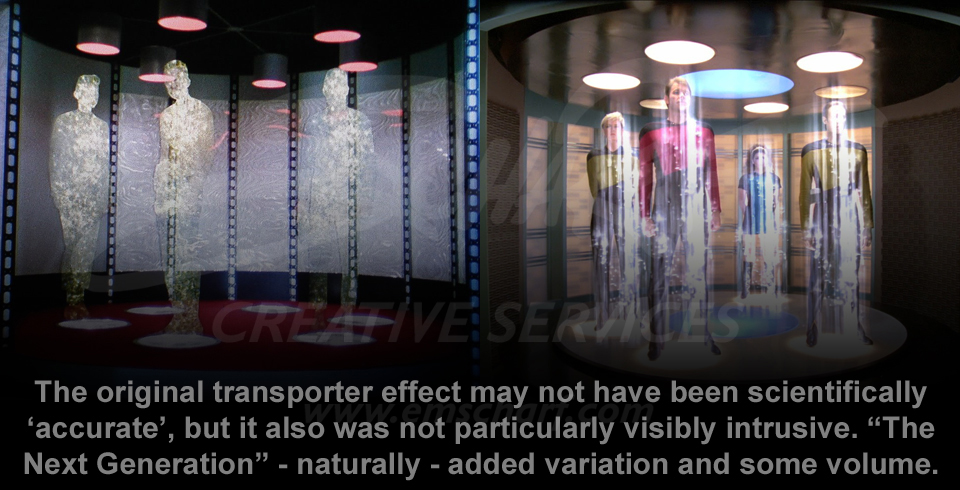
-
-
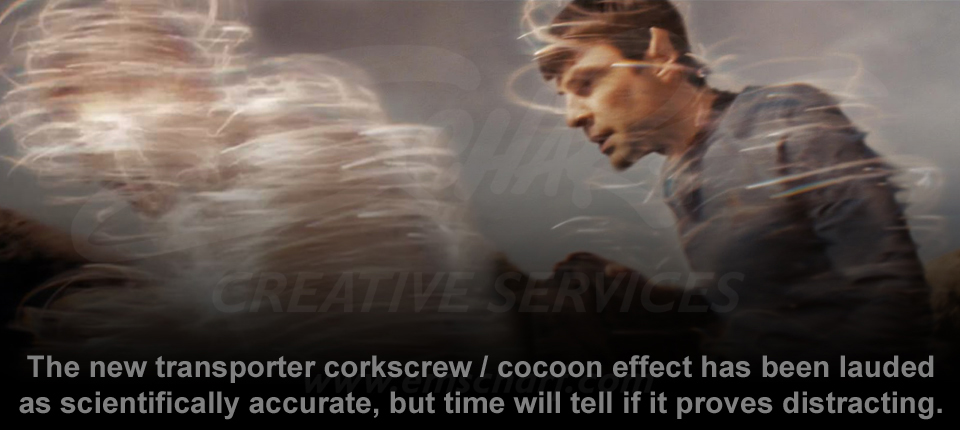
-
-
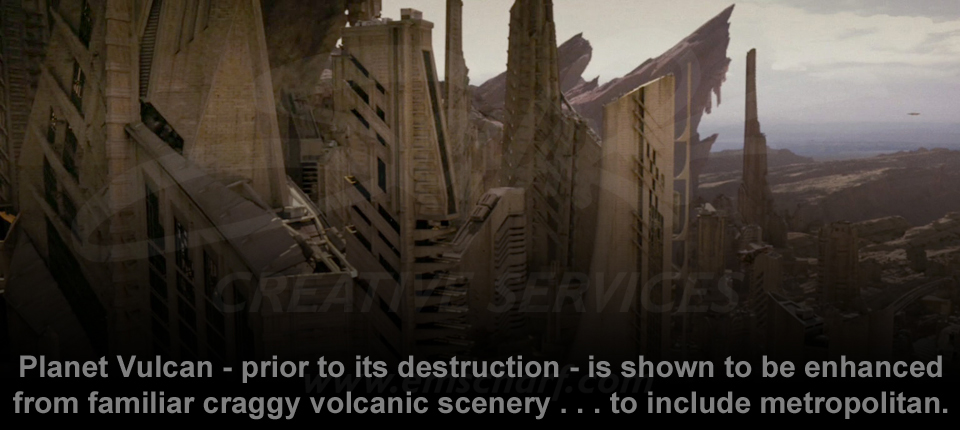
-
-
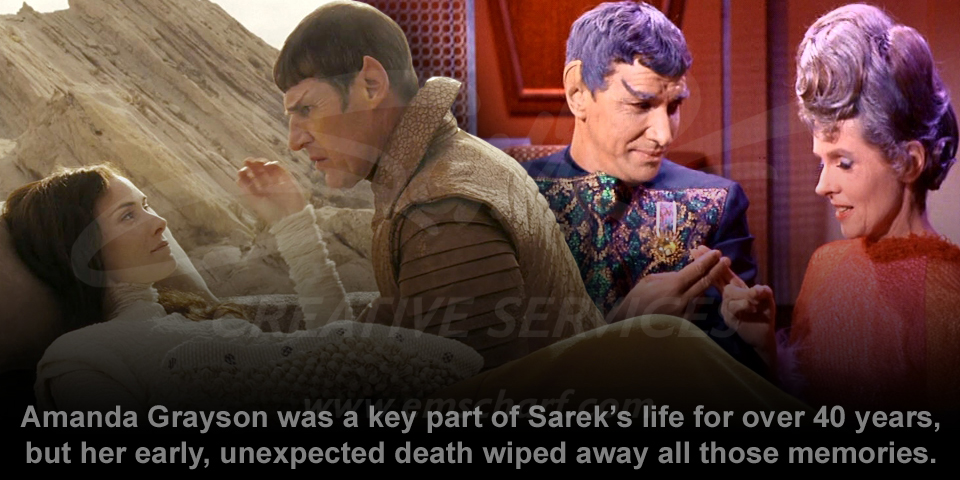
-
-

-
- Nero, without a moment of silence to
spare, sets out for Earth. He tortures Pike on the way, “Wrath
of Khan” style, for the command codes necessary to disable Earth’s
perimeter defensive systems.
-
-
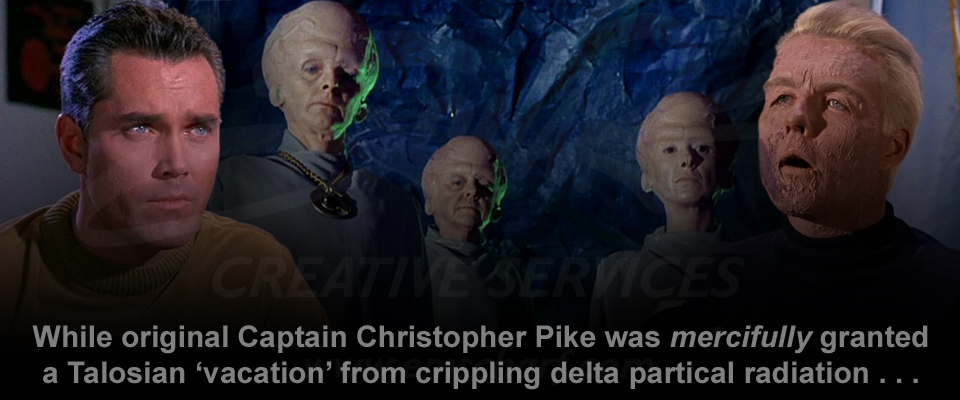
-
-

-
- Spock, in the meantime, intends to follow Pike’s instructions by the
book and rendezvous with the rest of the fleet. This infuriates the
proactive Kirk who insists on getting after Nero directly. A heated
argument ensues, and Spock decides to end the debate with the
cadet-turned-cheater-turned-first-officer. Spock applies a Vulcan
nerve pinch on Kirk and steals a page from Nero’s book of social
graces by leaving Kirk on the Hoth-like planet of Delta Vega.
-
-

-
- Spock, in his moment of devastating
loss, takes little solace in the tender moment Uhura shares with
him, exposing their completely unexpected relationship to amused and
confused fans everywhere.
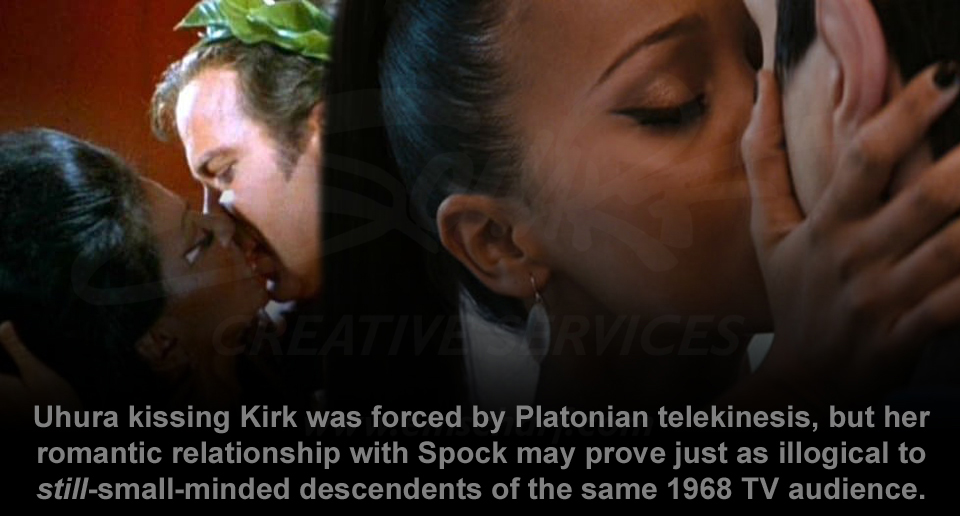
-
- After enduring a long-distance bait
chase across the icy surface of Delta Vega (in which Kirk is the
bait), Kirk stumbles into the same cave in which Spock Prime has been
surviving ever since being marooned by Nero. Spock Prime uses a
Vulcan mind meld to share the future's life-altering events with
Kirk. He compels the gob-smacked Kirk to
become captain of Enterprise in order to stave off certain doom.
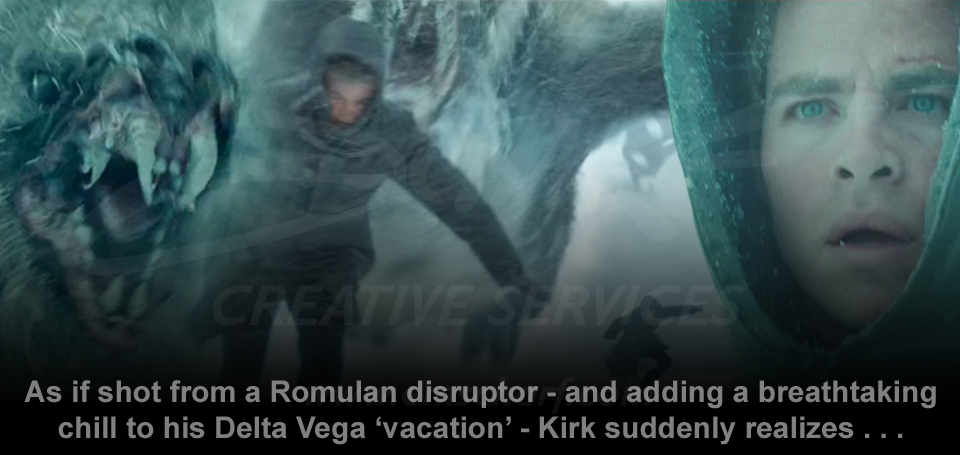
-
-

-
-

-
-
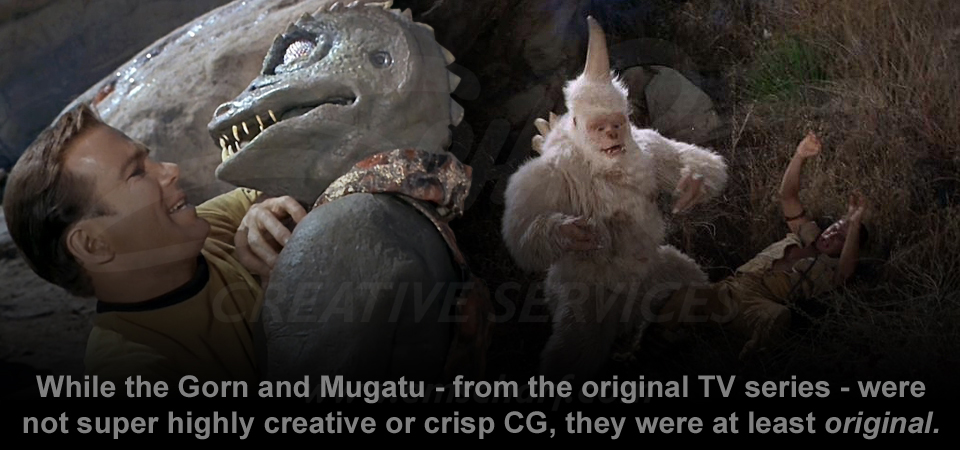
-
- After another hike through the snow, Kirk and Spock Prime
conveniently reach a Starfleet outpost where they meet none other
than Montgomery Scott.
Spock Prime explains their presence to Scotty and how he eventually
invents an algorithm that allows transporter beaming while a ship is
at warp speed. Scotty (going from pissed off and real-food-starved
to giddy and overwhelmed) is then beamed along with Kirk aboard
Enterprise. They materialize in the engine room where Kirk appears
safely on his feet . . . and an enclosed water tube ride ensues for
Scotty. He manages to hold his breath just long enough for Kirk to
reach a release valve that drops Scotty hard onto the engine room
deck.

-
-

-
-
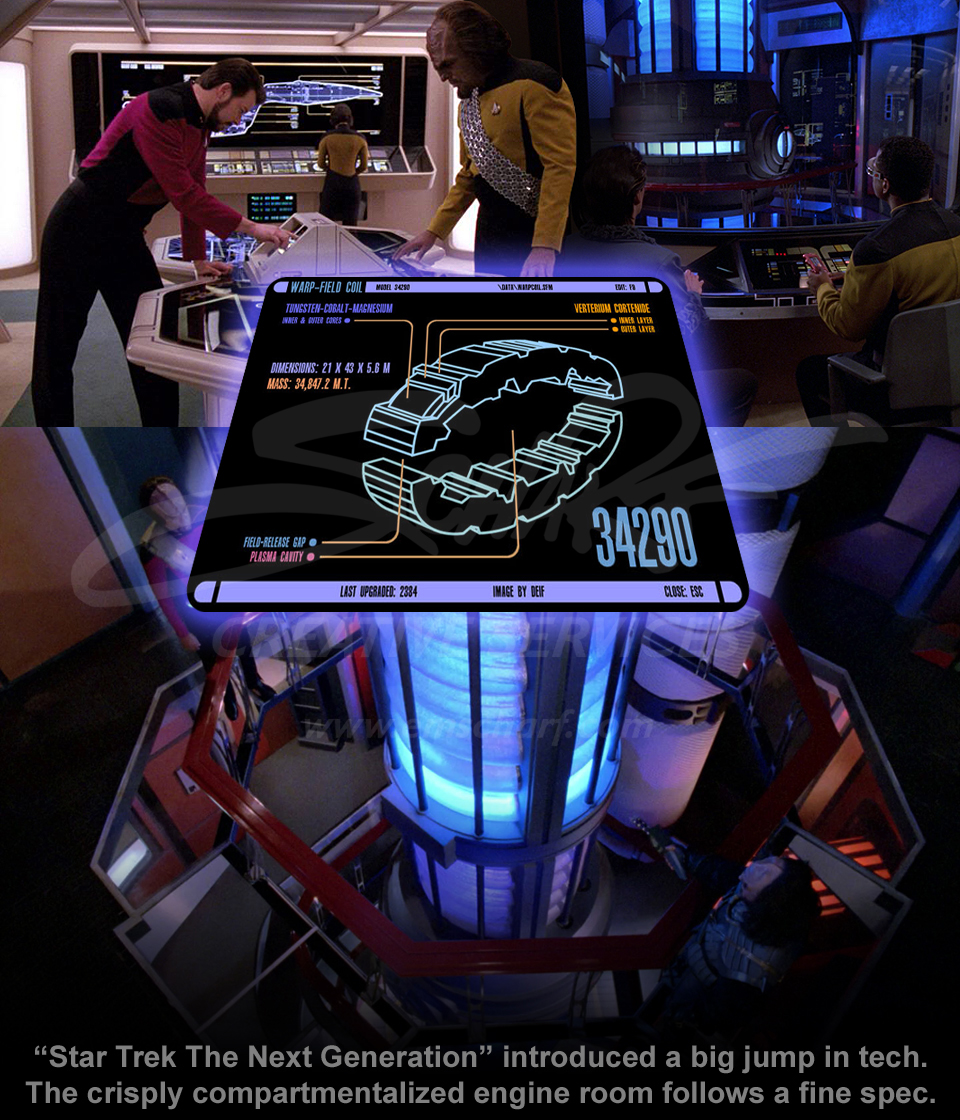
-
-
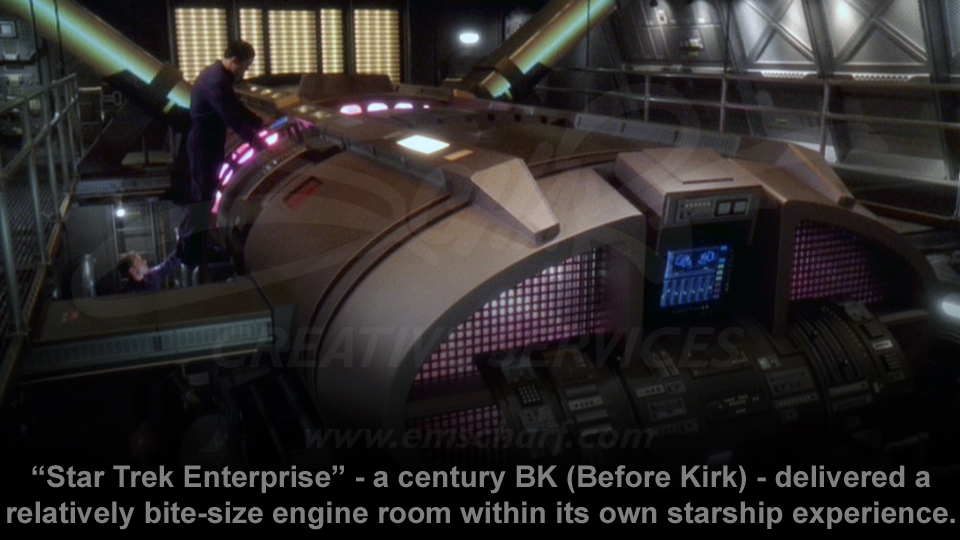
-
-
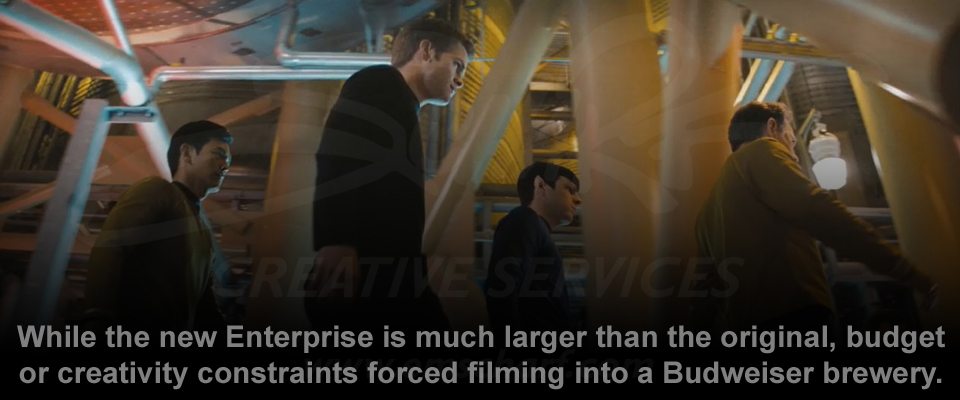
-
-

-
-
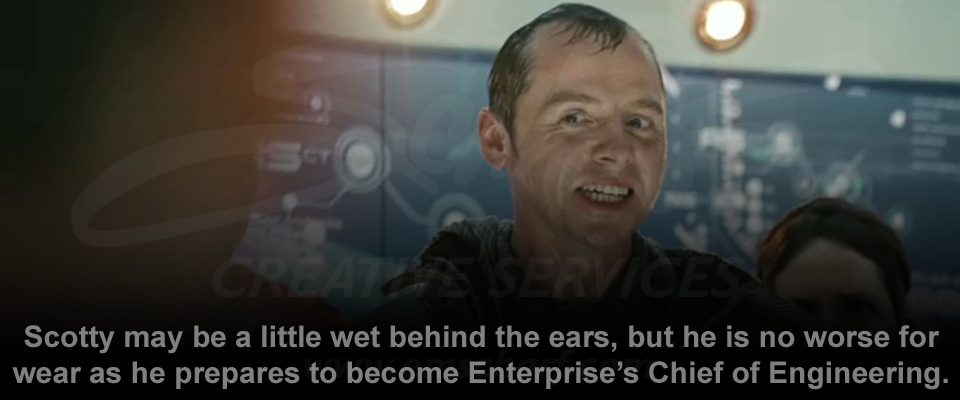
-
- Upon being escorted to the bridge by security, Kirk deliberately
confronts Spock (as instructed by Spock Prime). Spock is triggered
into a physical fight which nearly chokes the life out of Kirk
(before Sarek convinces him to stop). Spock is forced him to admit he is emotionally compromised
by the loss of his mother and his homeworld, thus, removing himself
from command and placing Kirk in charge. Kirk has mere seconds to
marvel at how he so quickly ascended from bait to first rate, and he
finds the Captain’s chair quite comfy.

-
-
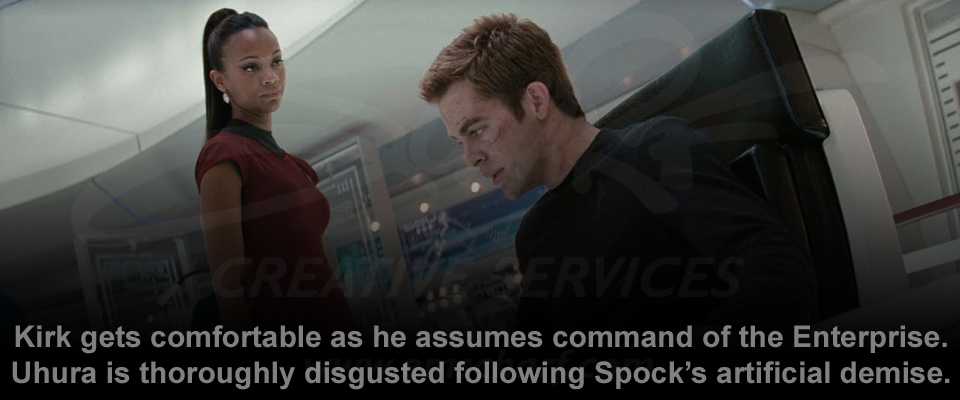
-
- After Spock composes himself (and is
eagerly welcomed back to the bridge as Kirk's first officer), he,
Kirk, Scottie, and Chekov cook up a plan
to surprise the Narada by dropping out of warp behind Saturn’s
largest moon, Titan (with Kirk and Spock beaming aboard to disable
the red matter device and recover Captain Pike). They will be out of sight but close enough,
they hope, for a sneak attack on the Narada before it reaches Earth.
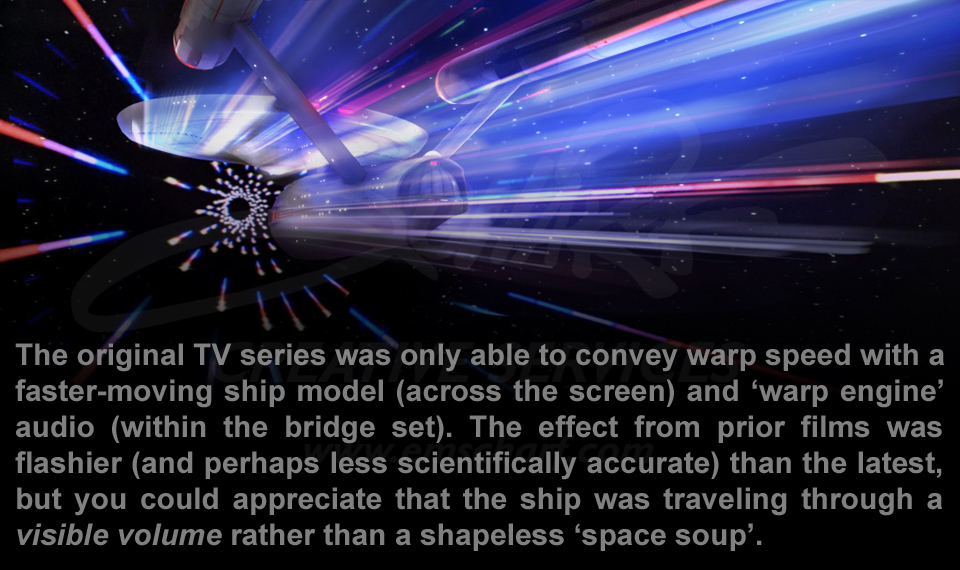
-
-
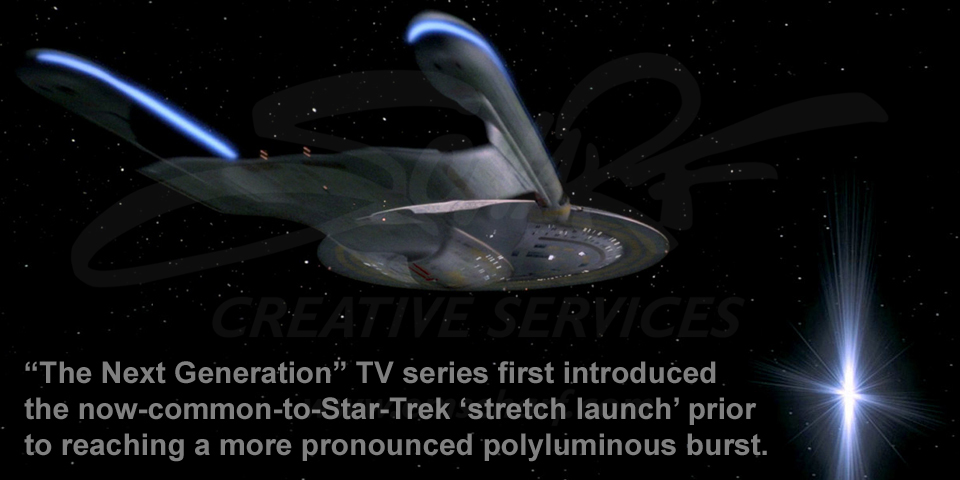
-
-
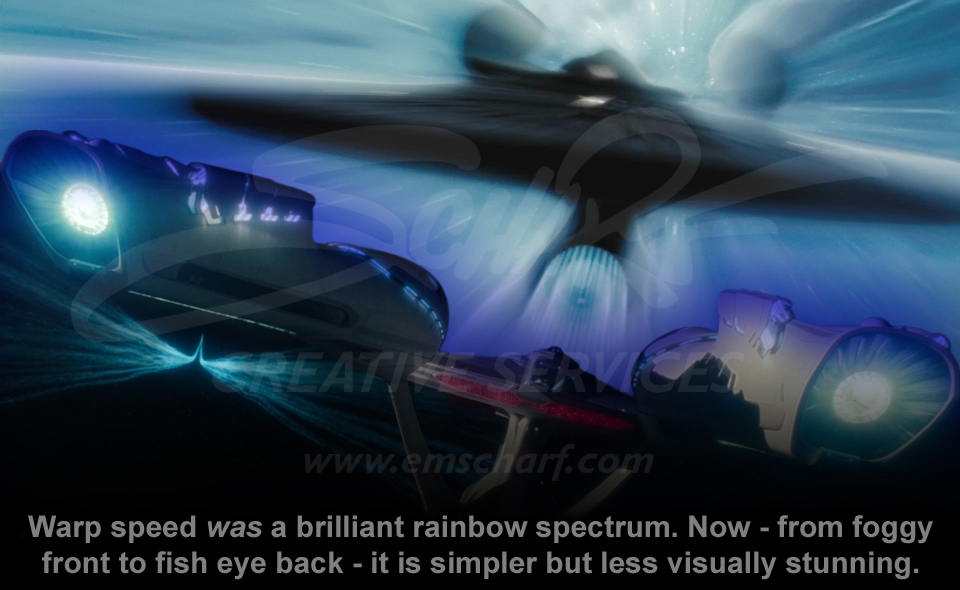
-
- They arrive too late to stop Narada’s drill
from beginning to
pierce Earth’s defenseless skin. Not only are Earth's perimeter
defense satellites offline, but it appears Nero really did wipe out
every available Starfleet ship save Enterprise.
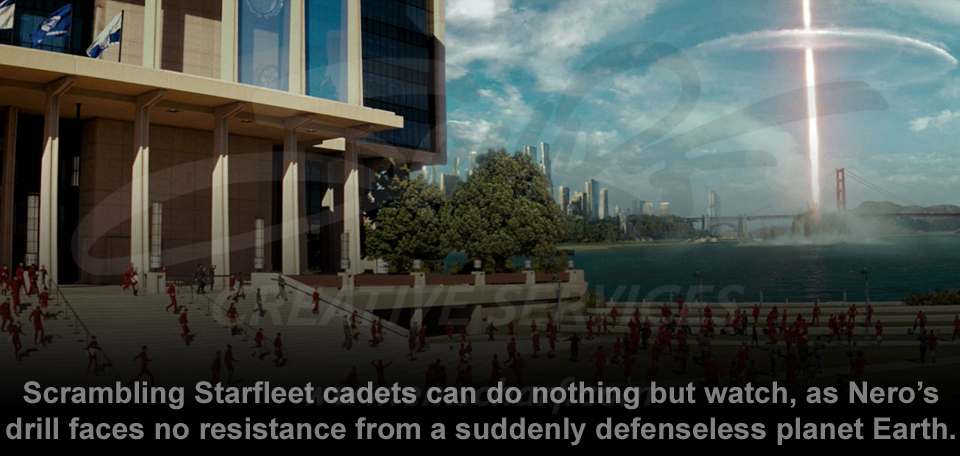
-
-
Kirk and Spock manage to navigate the
wildly-unfamiliar surroundings of the Narada and evade Nero's
disruptor-firing crew long enough to find the Spock Prime's ship. It
is now Kirk's turn to implore Spock to (ignore the ship's haunting
familiarity with the sound of his own voice and) use the ship (and
the only source of red matter) to
lead Nero away from Earth. Spock warps away to get Nero's undivided
attention.
-
A weary Kirk (having barely survived his second
physical mismatch of the day) successfully locates the
bent-but-not-broken Pike. Nero has no choice but to spare Earth from
Vulcan's demise and chase after Spock. Kirk and Pike are safely
beamed back aboard Enterprise.
-
-
The Narada easily catches up to Spock, but Nero is wholly unprepared
for another head-on encounter (with a much smaller craft than the
Kelvin but with incomparably deadly cargo). Nero orders his crew to
"Fire EVERYTHING!" . . . knowing full-well that ignition of
the red matter too close in proximity to the Narada will mean the
end.
-
-
Just when filmgoers expect the barrage of fired ammunition to
explosively halt Spock's suicidal trajectory, Enterprise suddenly
appears and clears all obstacles from his "rubber road to freedom"
(as the "Night Rider" from "Mad Max" would say). Right before Spock's
ship makes its fatal impact, Enterprise beams him aboard.
Kirk, in a rare show of playing by the rules, offers to rescue
Nero and his crew from certain death. He even consults the
always-by-the-book Spock who, under the circumstances, is all for
throwing the book away. Still, Kirk offers Nero an intergalactic
olive branch, but Nero "would rather suffer the end of Romulus a
thousand times (than accept help from you)." Before the Narada implodes into the black hole,
Kirk gives the order to “throw everything we have at 'em.”
The Media Magnate, in relation to Kirk's order to "empty the clip,"
believes other moviegoers also
noticed (throughout the film) how the phasers and photon torpedoes were pesky: from the
laser beams to the projectiles to the lighting effects,
there was no "shock and awe" visually-intimidating reason to fear Enterprise like an enemy might from
previous “Star Trek” films.
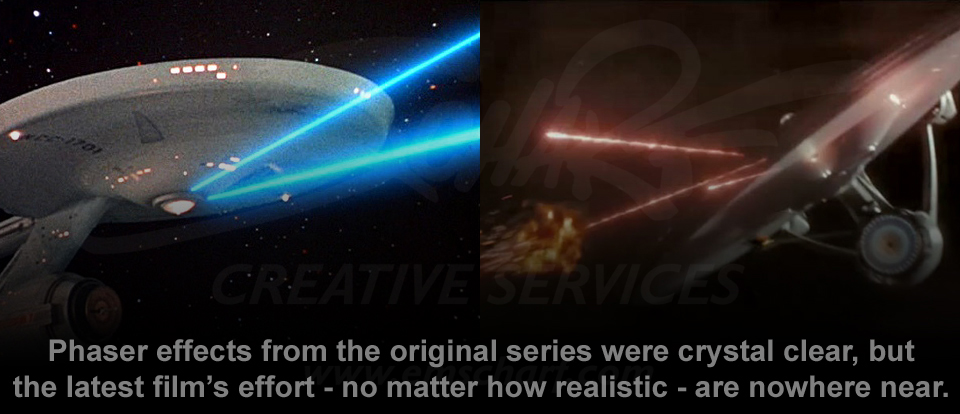
-
- Once Enterprise has completed the fireworks assist, the crew is
caught off guard by the strength of the red matter-generated black
hole. The warp drive proves as effective as the Millennium Falcon
attempting to escape the tractor beam of the Death Star. The
Enterprise's interior begins to crack, and there is no time to
experience the same with the outer hull. The crew's only chance to
escape the Narada’s fate is for Scotty to eject and remote-ignite Enterprise's warp cores, resulting in an explosion that
propels them clear of the black hole’s voracious grip.
A ceremony takes place back at Starfleet Academy where Pike (wheelchair-bound and still recovering from his encounter with Nero)
is promoted to Admiral, and Kirk is promoted to captain of Enterprise.
It is touching to see Kirk officially relieve Pike from his
captaincy with Pike saying "I am relieved (that you relented
and proved to yourself what I knew you could achieve)."
-
- A few scenes before the film draws to a close, Spock is
searching for Sarek in a nearby hangar when he stumbles upon Spock
Prime, who is departing to help find a new homeworld for any
remaining Vulcans.
-
- Spock tells Spock Prime of his desire to leave
Starfleet and join the rebuilding effort. Spock Prime tells Spock
that he and Kirk are a team and will develop a great friendship as a
result, but that he should do what he ultimately feels is the right
thing to do. Spock heeds this advice and chooses to remain in
Starfleet as Kirk’s first officer.
That scene where Spock Prime tells Spock to do what he feels is
right could easily have drawn more attention to their half-human
/ half-Vulcan heritage, and it loosely reminded me of
the following early scene on Vulcan from “Star Trek 4: The Voyage Home”
where Spock Prime is continuing the reawakening of his memory to its
former razor-sharp glory.
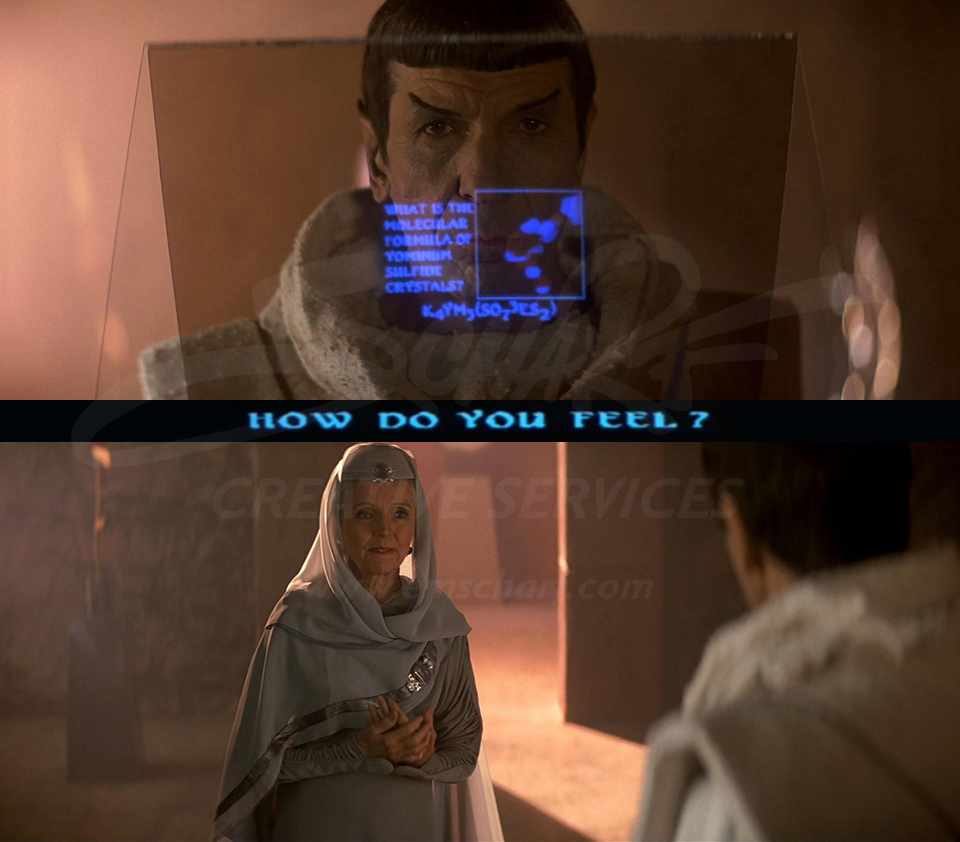
-
- Computer: "How do you feel? How do you feel? How do you feel?"
- Spock: "I do not understand the question."
- Amanda Grayson: "What's the matter, Spock?"
- Spock: "I do not understand the question, mother."
- Amanda Grayson: "Well, you're half-human. The computer knows that."
- Spock: "The question is irrelevant."
- Amanda Grayson: "Spock, the retraining of your mind has been in the
Vulcan way so you might not understand feelings, but as my son you have
them. They will surface."
- Spock: "As you wish, if you deem them necessary. However, I cannot
wait here to find them. I must go to Earth, to offer testimony."
- Amanda Grayson: "You do this...for friendship."
- Spock: "I do it...because I was there."
- Amanda Grayson: "Spock, does the good of the many outweigh the good
of the few?"
- Spock: "I would accept that as an axiom."
- Amanda Grayson: "Then you stand here due to a mistake, made by your
flawed, feeling friends. They have sacrificed their futures,
because the good of the one, you, was more important to them."
- Spock: "Humans make irrational decisions."
- Amanda Grayson: "They do, indeed."
Conclusion
Abrams made no attempt to hide his casual fan admiration and
approach to “Star Trek.” His Paramount-backed mission was to deliver
a successful rebirth of the franchise, introducing new actors in key
roles using enough familiar material to satisfy hardcore Trekkies
while limiting the amount of techno-babble to a degree that would
encourage casual Trekkies and mainstream filmgoers to show interest
as well.
Yes, there were, in fact, communicators, tricorders, and phasers in
this film, but the focus, to the dismay of
many, was on the story and characters being re-developed within it .
. . not their gadgets (and with good reason - SEE below). Was a veiled reference
just made to “Quantum of Solace?” Read The Media Magnate's
review to find out.
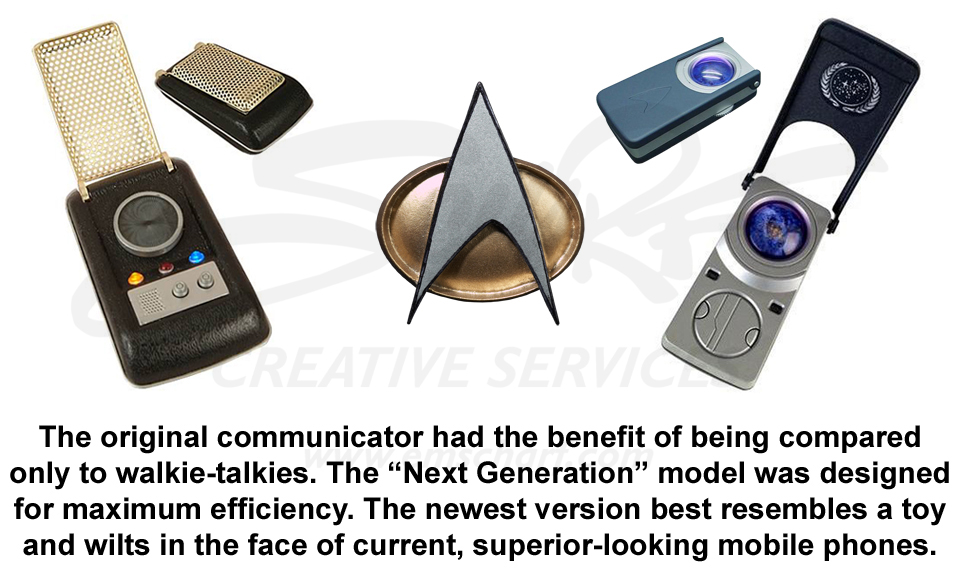
-
-

-
-
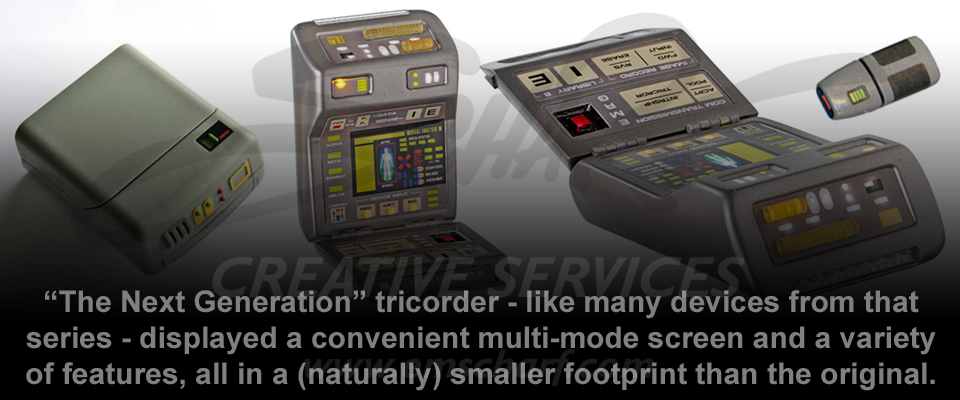
-
-

-
-

-
- If you take an opinion poll from all three target
audiences, then you will agree that Abrams has succeeded with his
risky mission of partially rewriting an internationally-known and
exponentially-famous science fiction franchise.
There are certainly a number of hard core fans who also believe that
Abrams kicked the franchise’s history and loyal fan base to the
curb. "Tickle us, do we not laugh? Prick us, do we not bleed?
Wrong us, shall we not revenge?" - Klingon General Chang.
-
- THAT opinion, however, points to the deepest issue any fan
can have when their favorite escape from reality appears to have
been threatened with a(n unrequested) face lift. It is incredibly hard to let go of a well-worn baseball glove in
favor of a new one. The original core actors,
their characters, the stories that surround them, and overall history of a franchise like “Star
Trek” has proven extendable but . . . modifiable (without
appearing maligned)? "What once was old is new again," but to
some, change will always be strange.
And, yet, it is even harder for The Media Magnate to see those familiar faces grow
older by the day (with two deceased and the remaining four in their
late 70’s if not older) without any attempt by Paramount to bring in
a new, younger cast that can allow such beloved characters to
continue boldly going where no one has gone before.
Do you love a thing to death, or, do you love a thing enough to let
it evolve? This is the question all long-time “Star Trek” fans need
to ask themselves. If you cannot stand change or risk, then, Abrams
should never have been allowed to create the latest film. If you
want new television series and new films, then, you must find it
within yourself to show some flexibility, rather than allow yourself
to get caught in an infinite loop.
“Let’s see what’s out there.” – Jean Luc Picard.
“Second star to the right and straight on 'til morning.” – James T.
Kirk.
Was Abrams’s effort perfect? No.
Did he take a number of liberties, some of them questionable, in order to engage a much broader
audience? Yes.
Did he make the core characters a bit more edgy? Maybe . . . as the
original “Star Trek” series was created against an entirely different set of
social standards (which have changed "just a bit" with every year that passes).
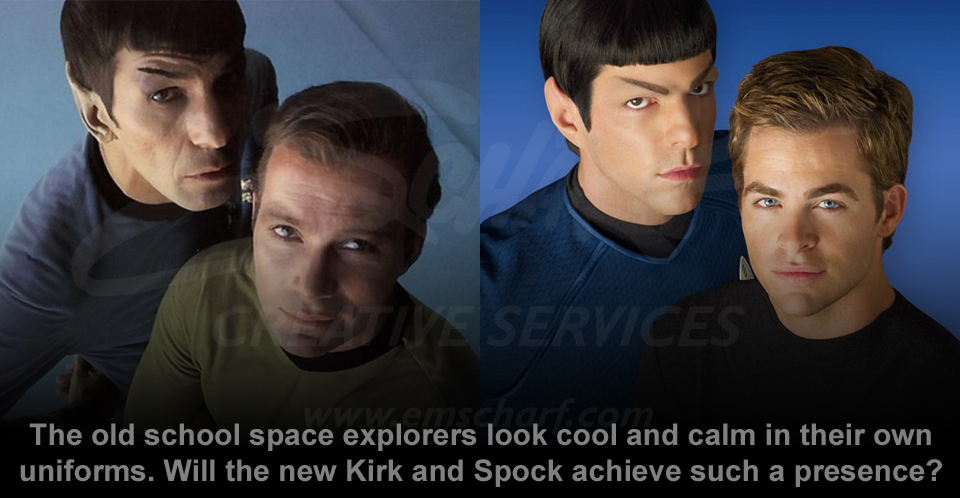
-
- Will the new actors ever become as comfortable in their Starfleet
uniforms as the original cast? Maybe . . . but how on Earth do you
develop the same comfort level as those who had and have been doing
it for over four decades? Is that a fair expectation of actors who
may only be associated with “Star Trek” on a film by film basis (generously
every 2-3 years),
rather than multiples of television series, films, video games, and
location-based entertainment?
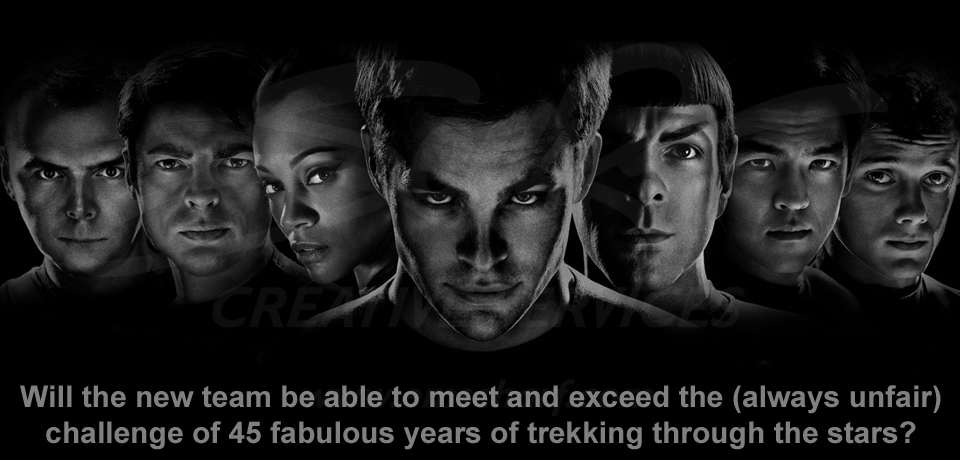
-
- Does the time travel element give
Abrams or another director the flexibility to properly address any
missing historical components in future films? Yes and, ultimately,
that may be all that counts. The Media Magnate is willing to give the
director of the next film or two a shot at putting more of that
wonderful “Star Trek” history to work.

-
- Paramount has an incredible
opportunity that it probably never saw coming: the chance to keep
most of the hardcore fans and add an entirely new fan base. They
will either take full advantage of this situation, delivering on the
potential established with this latest film, or they will do what most
fans expect from film executives who increasingly appear out of
touch: fall flat on their pompous, market-driven faces.
Still, those executives need to succeed. Fans should want their cake (with
both familiar and new ingredients) and eat it,
too (with improved serving utensils). Fans should want
new-and-capable faces to conquer the daunting challenge of replacing
- no, continuing - the interstellar work of a beloved set of
internationally celebrated space travelers. If it does not work out,
fans will always have that rich and undeniable history.
The universe, however, is simply too vast to leave well enough alone
. . . and allow "Star Trek" to
permanently fade away into the annals of ON DEMAND or so many DVD
and Blu-Ray box sets. After all, when Carly Simon wrote the lyrics
to "Nobody Does It Better" - for the 1977 James Bond film "The Spy
Who Loved Me" - how do we really know she was not actually
thinking about Star Trek offering the best experience in space
travel?
"Space: the final frontier. These are the new voyages of the
starship Enterprise. Its ongoing mission: to explore even more
strange new worlds; to seek out even more life and even newer
civilizations; to boldly and respectfully go, with new actors and
without fear of retribution, where no director has gone before."
-
- "Once more unto the breech,
dear friends."
|